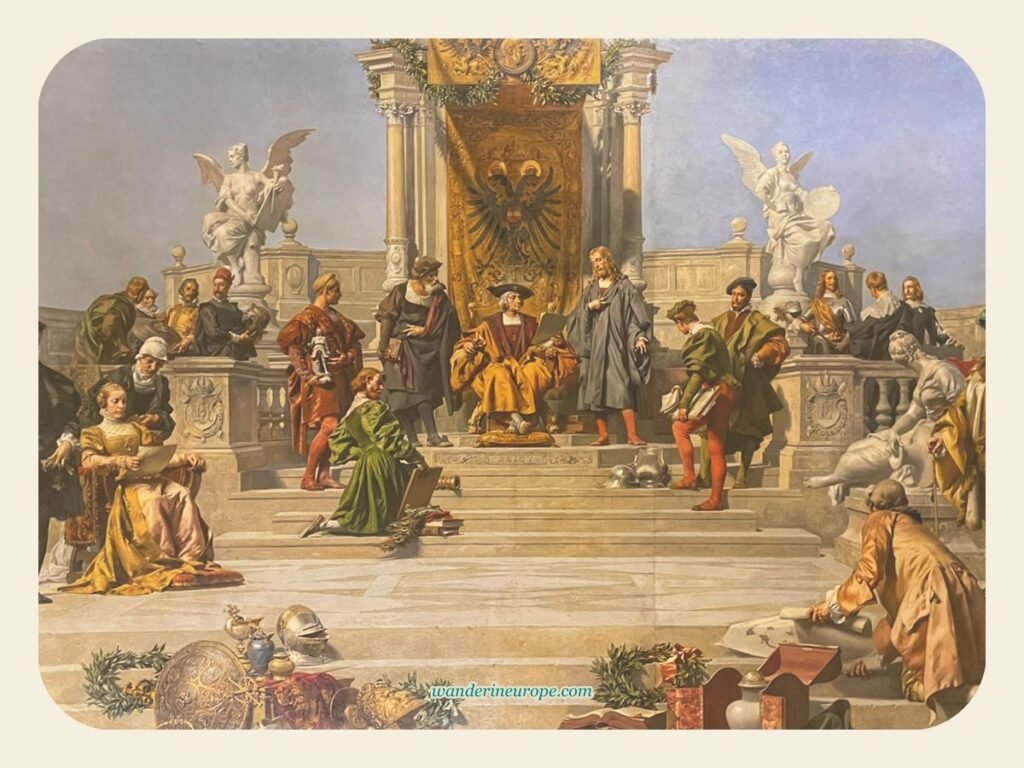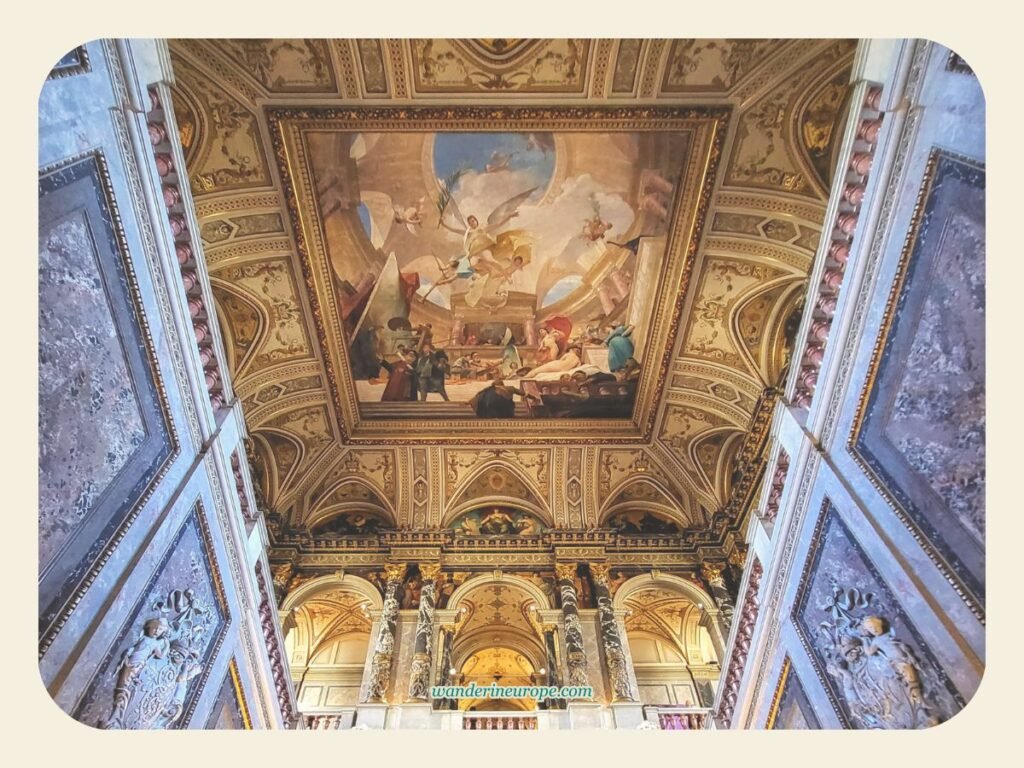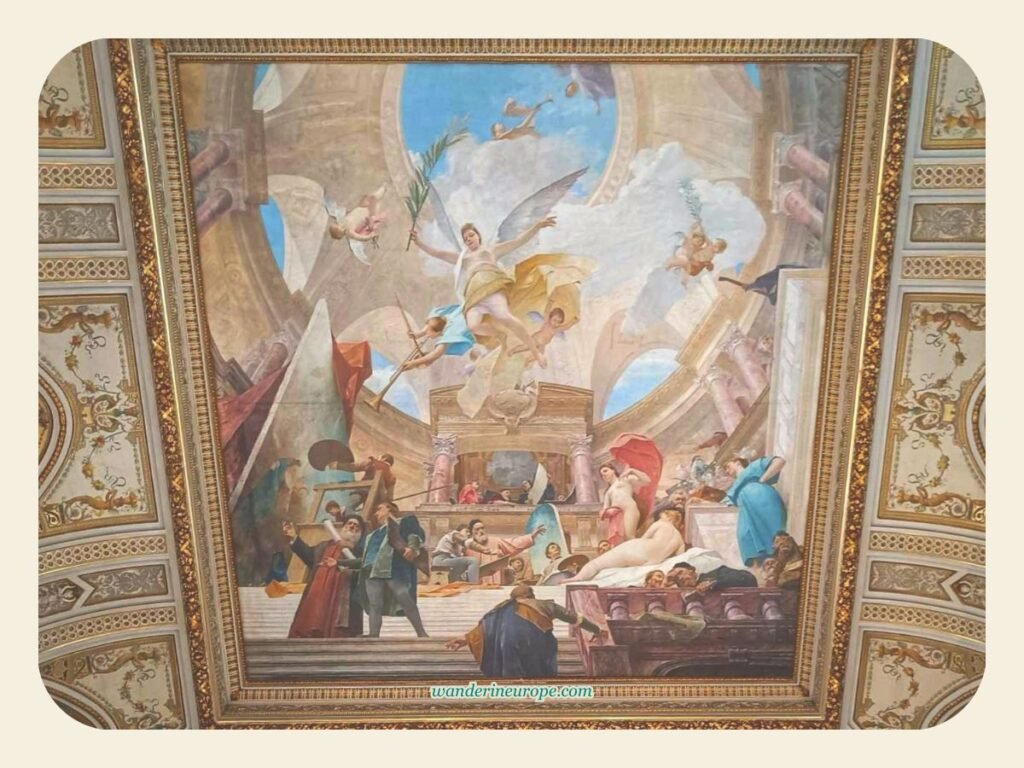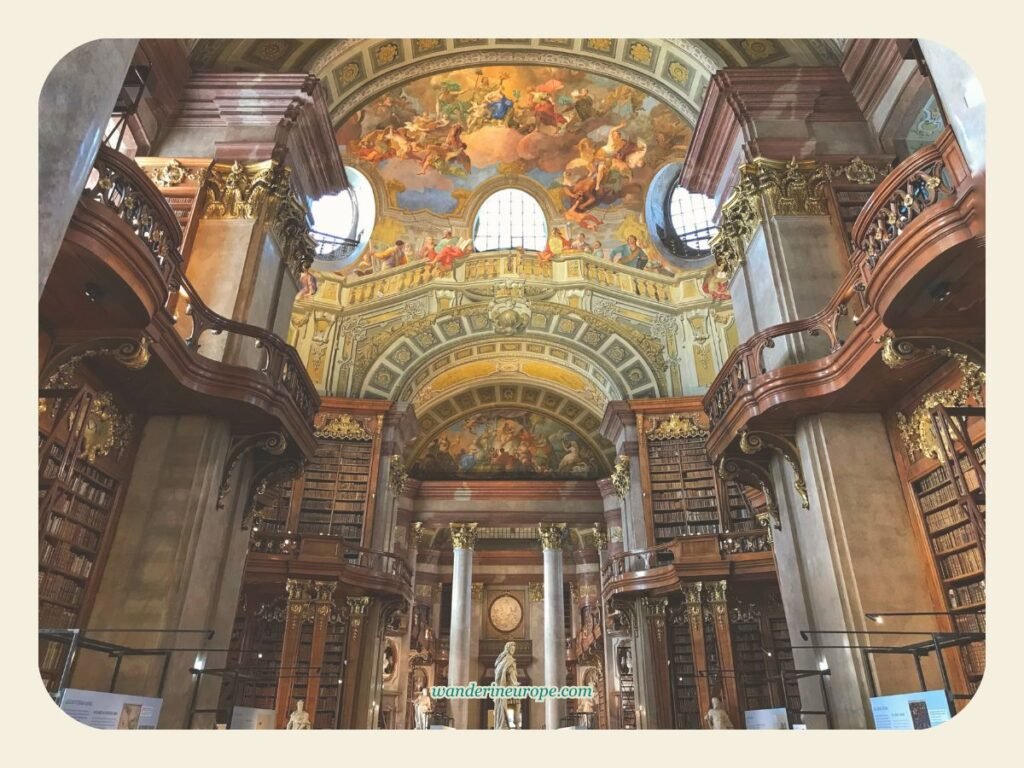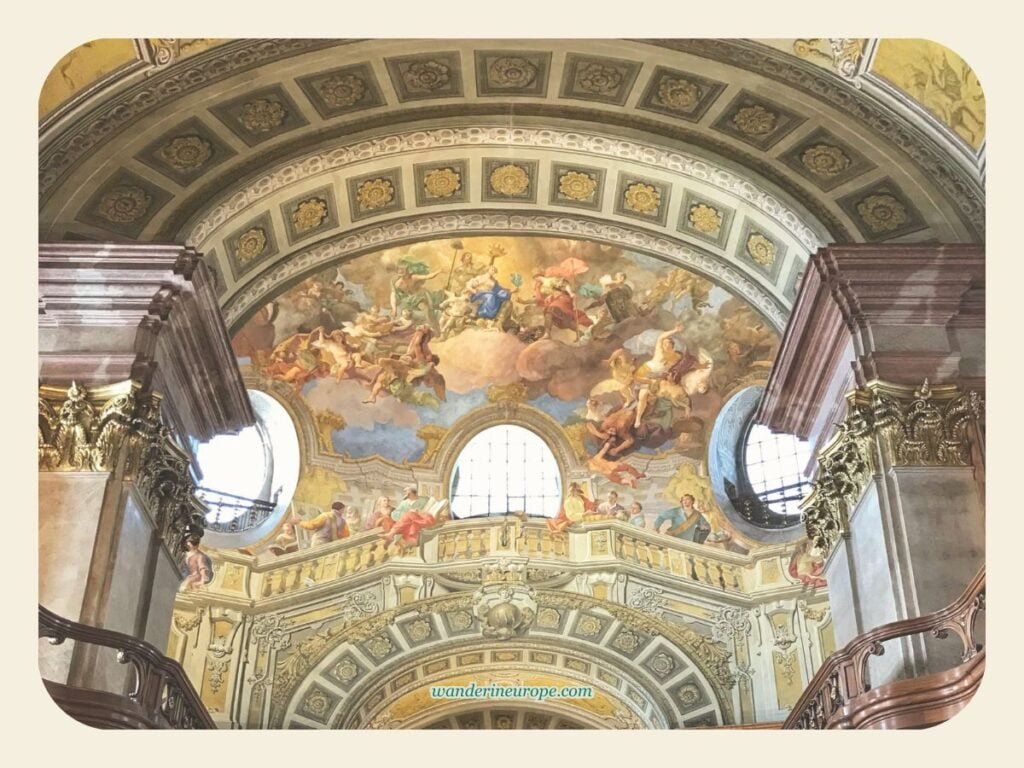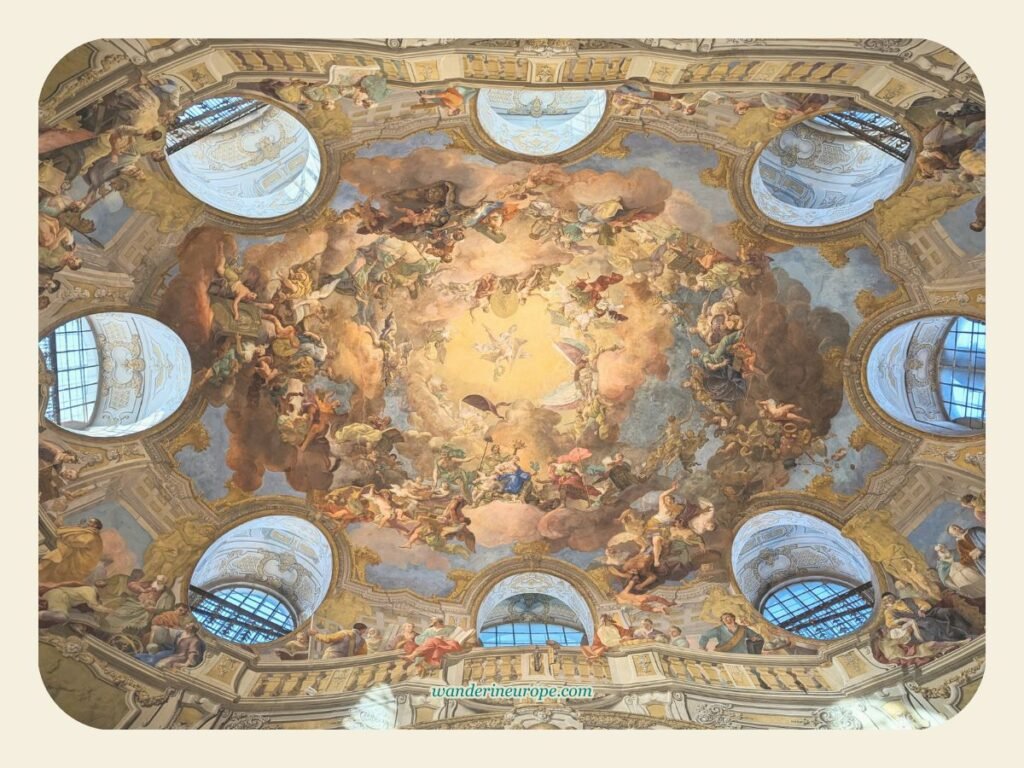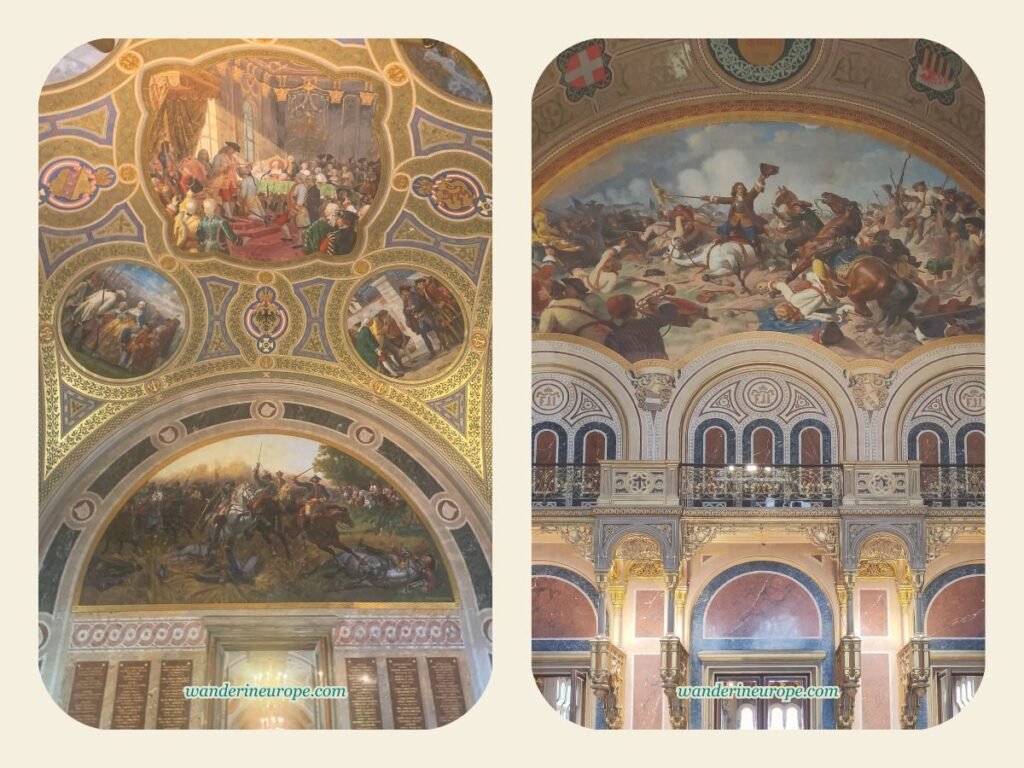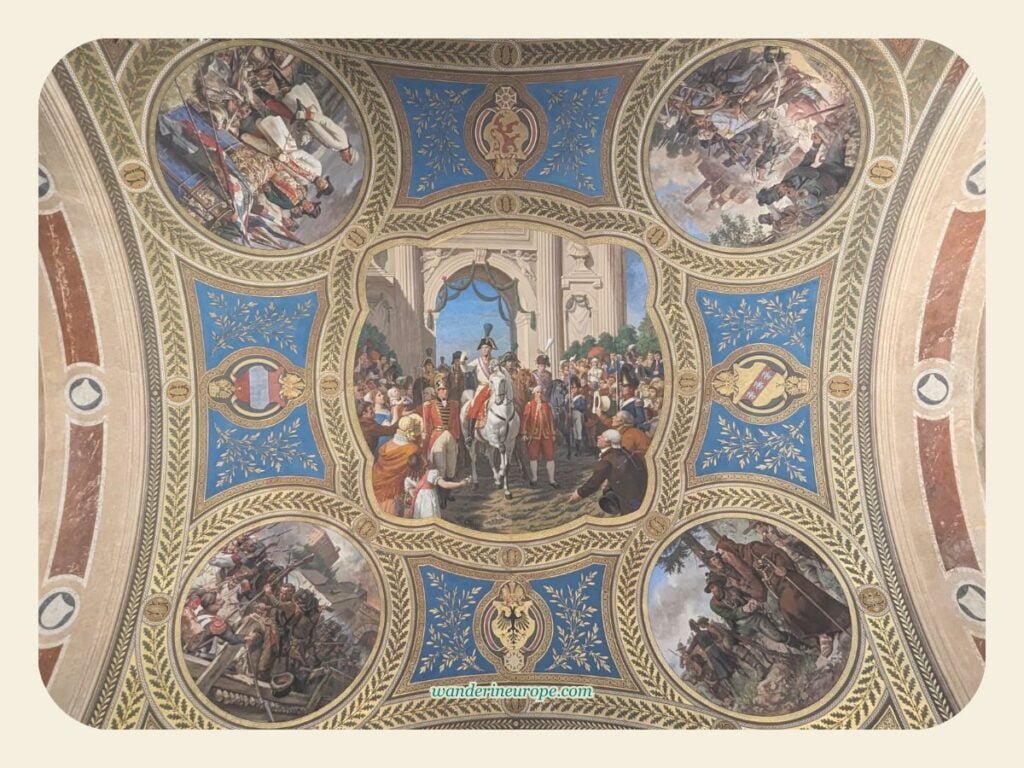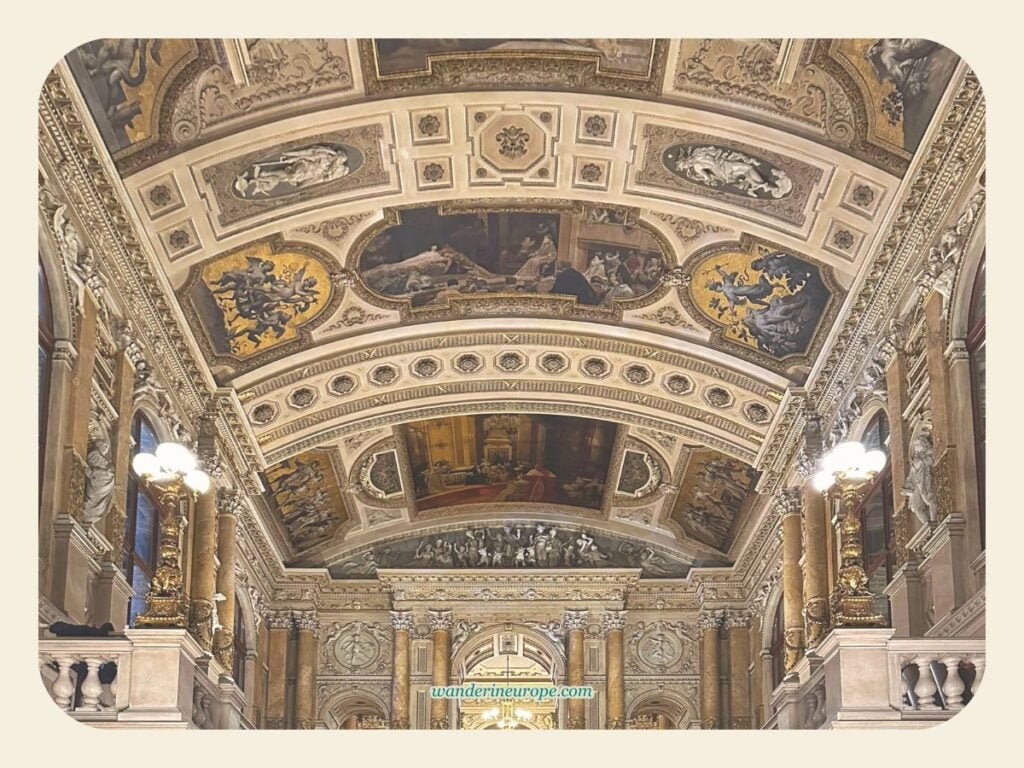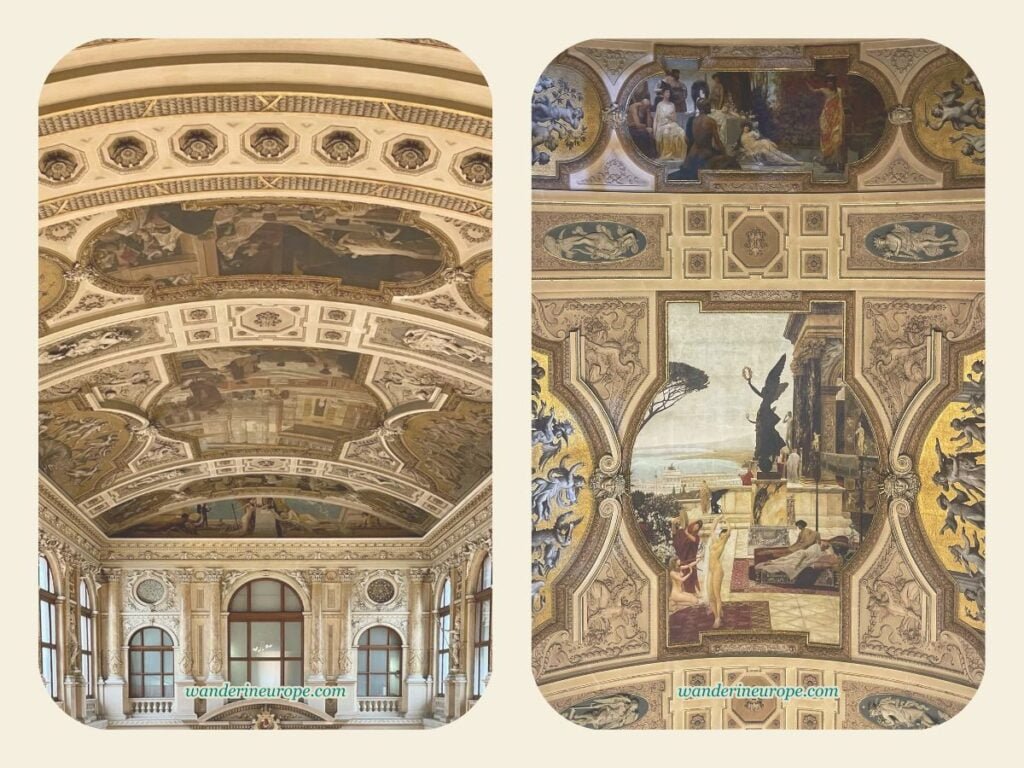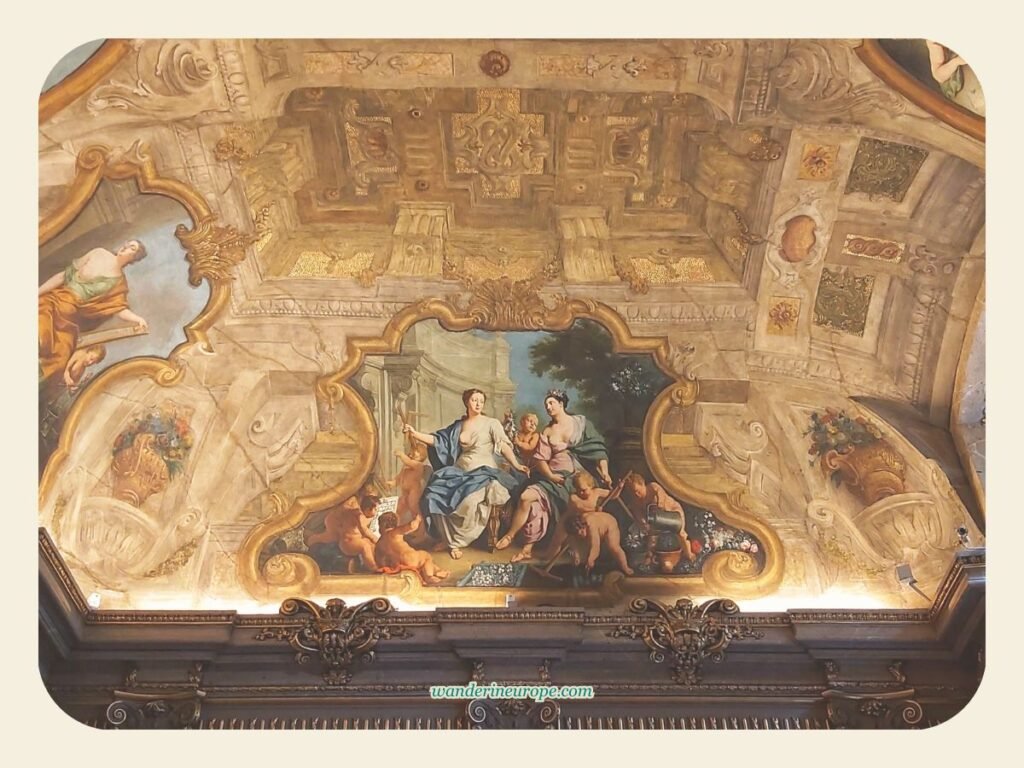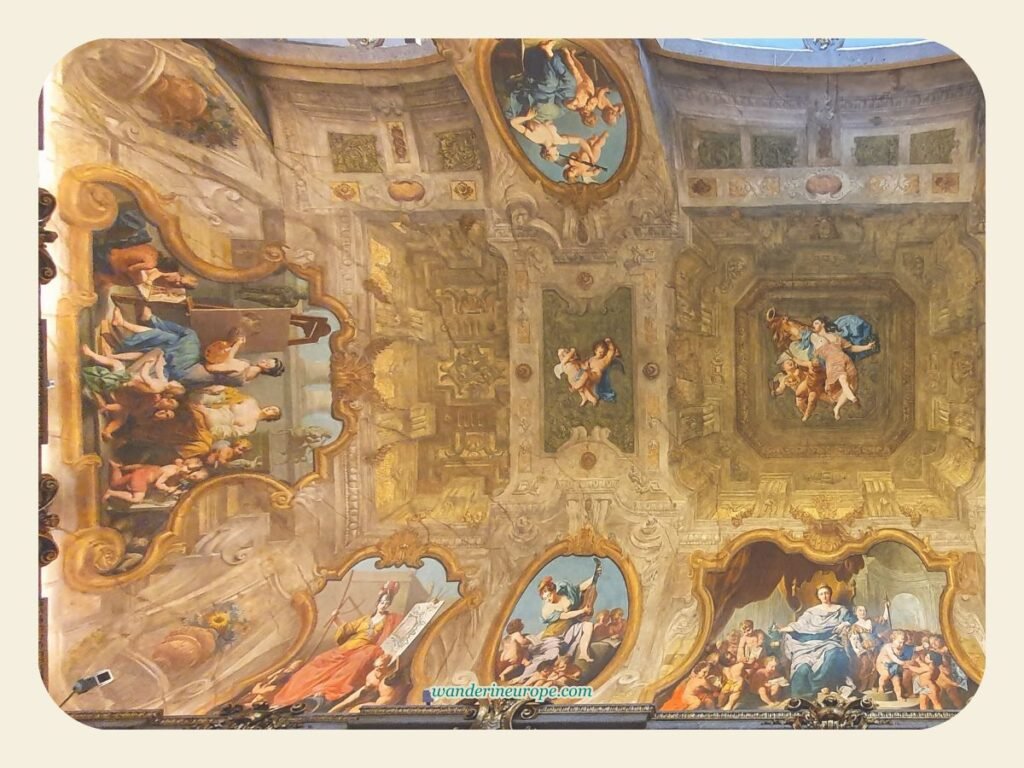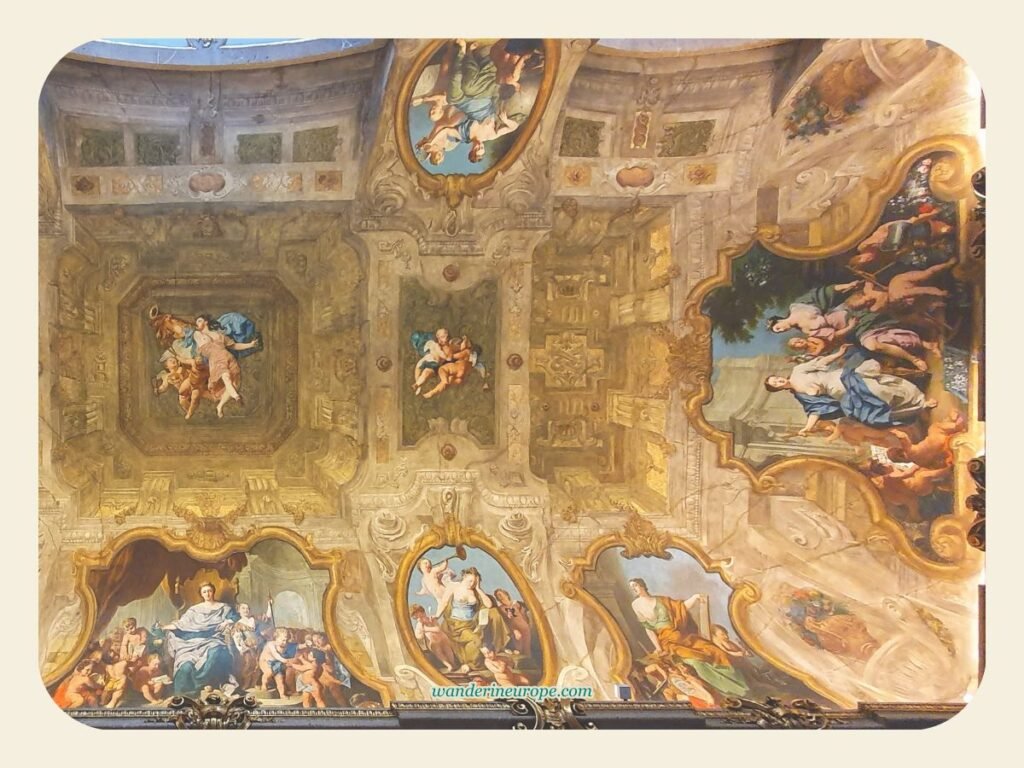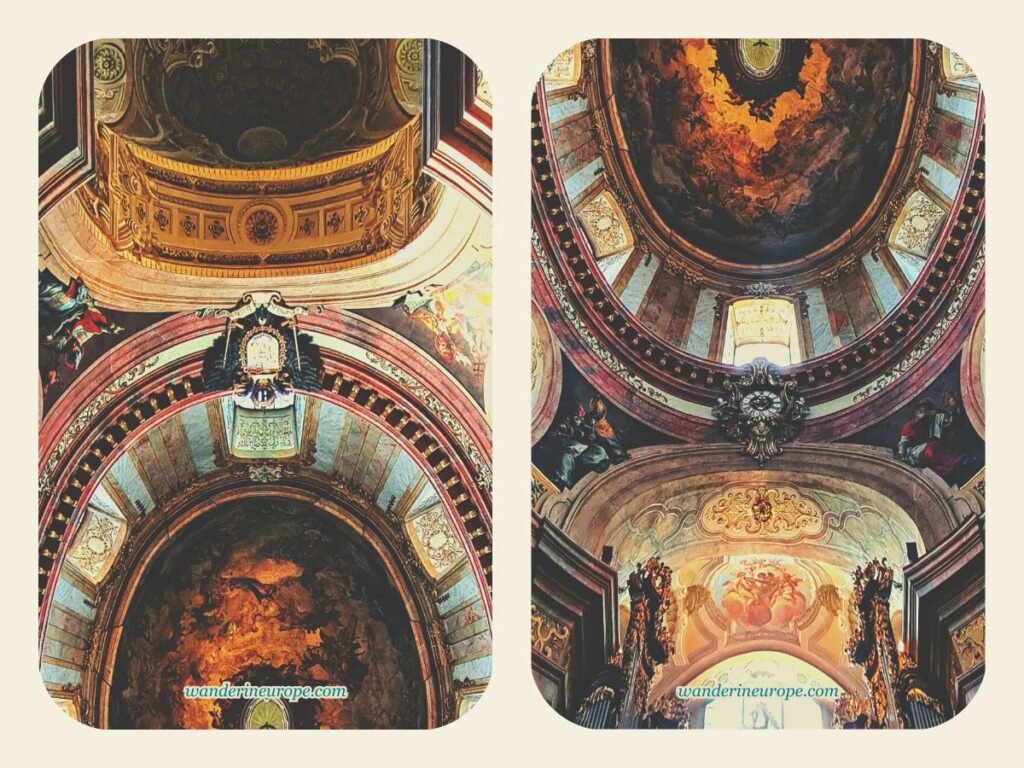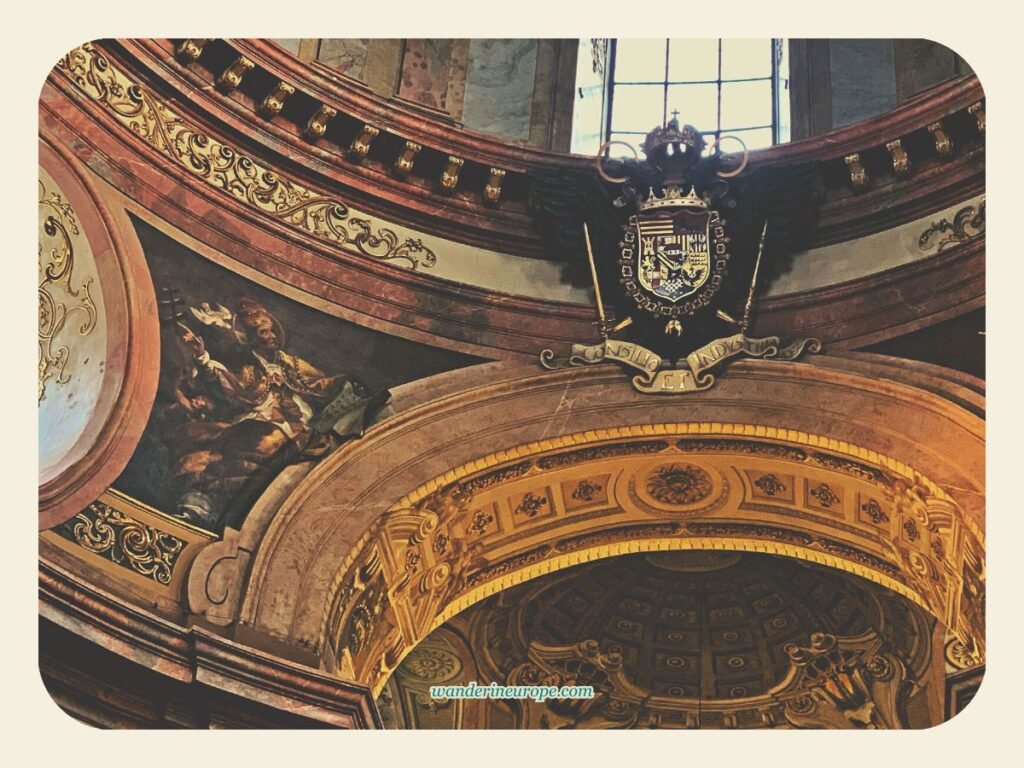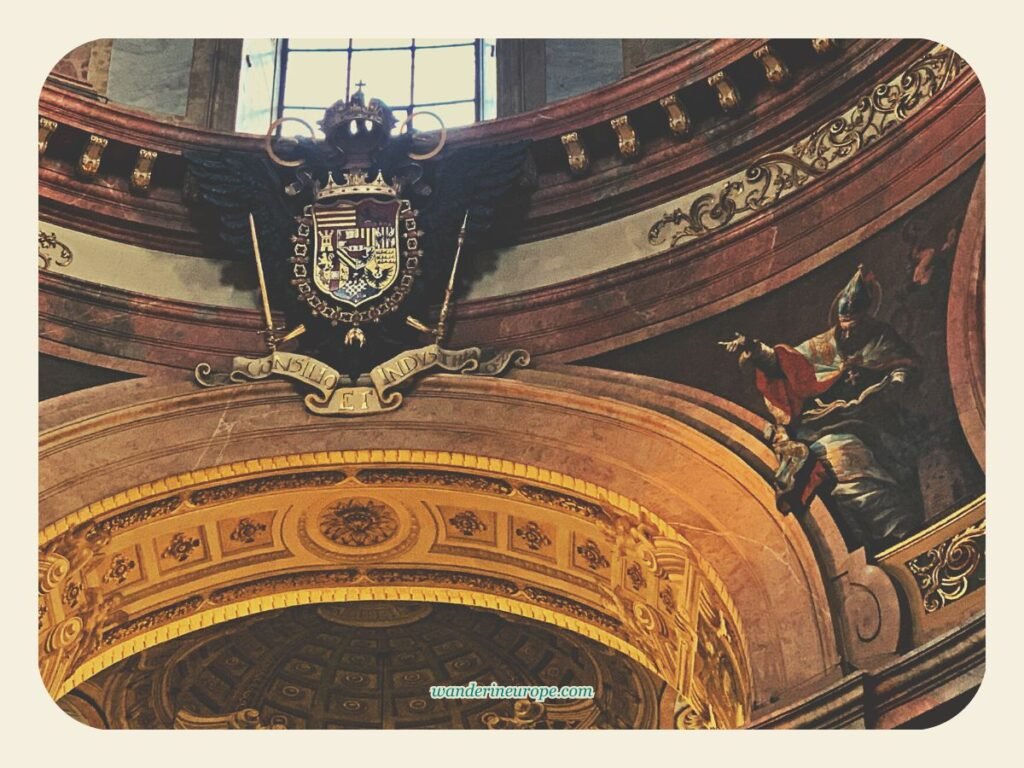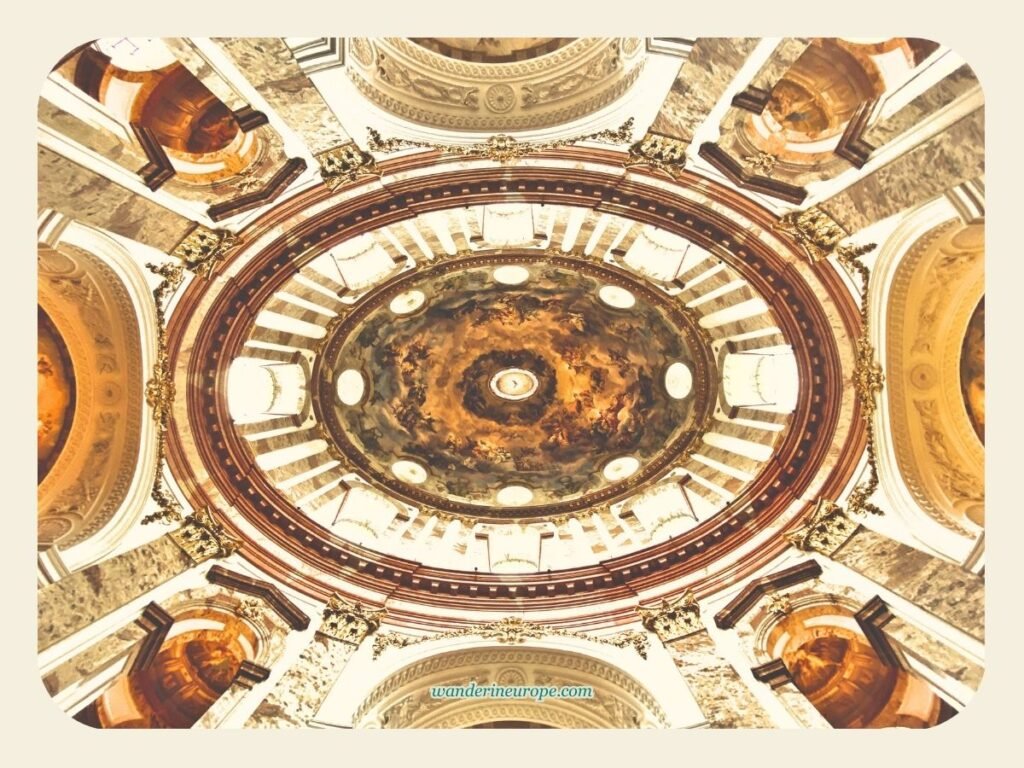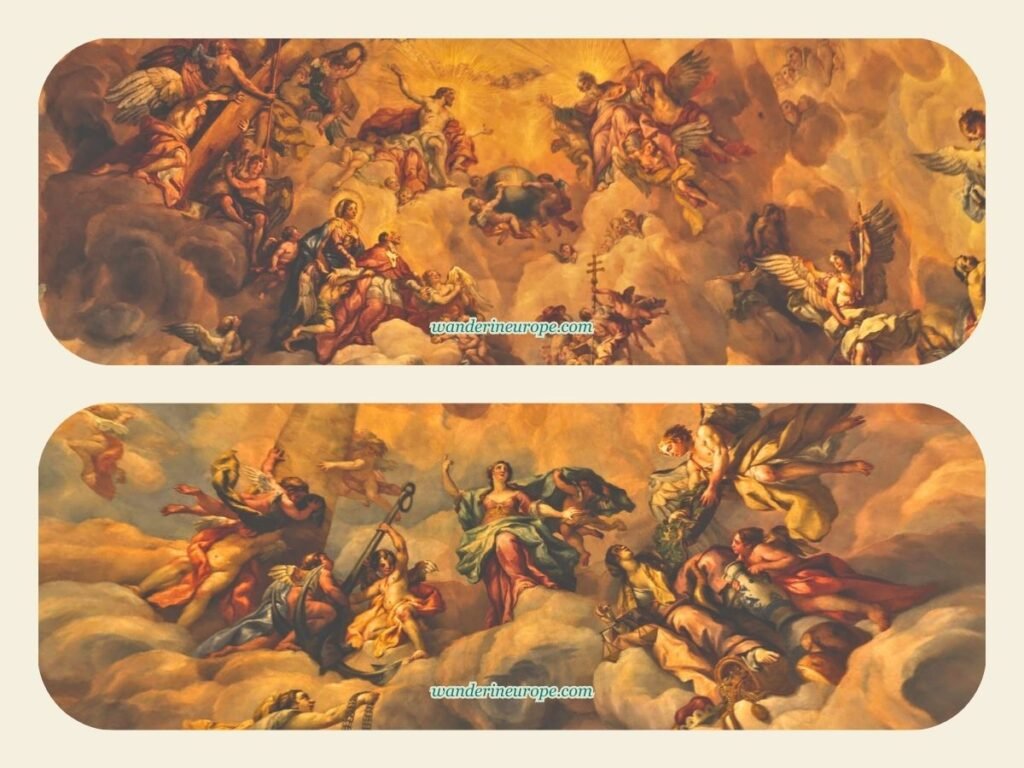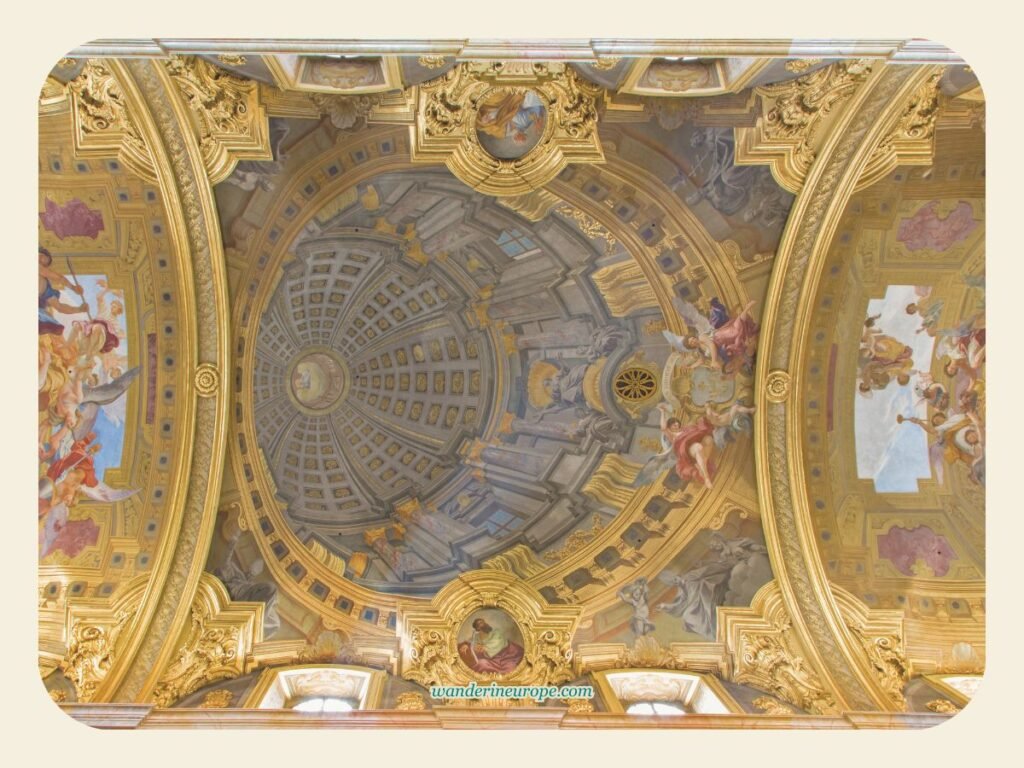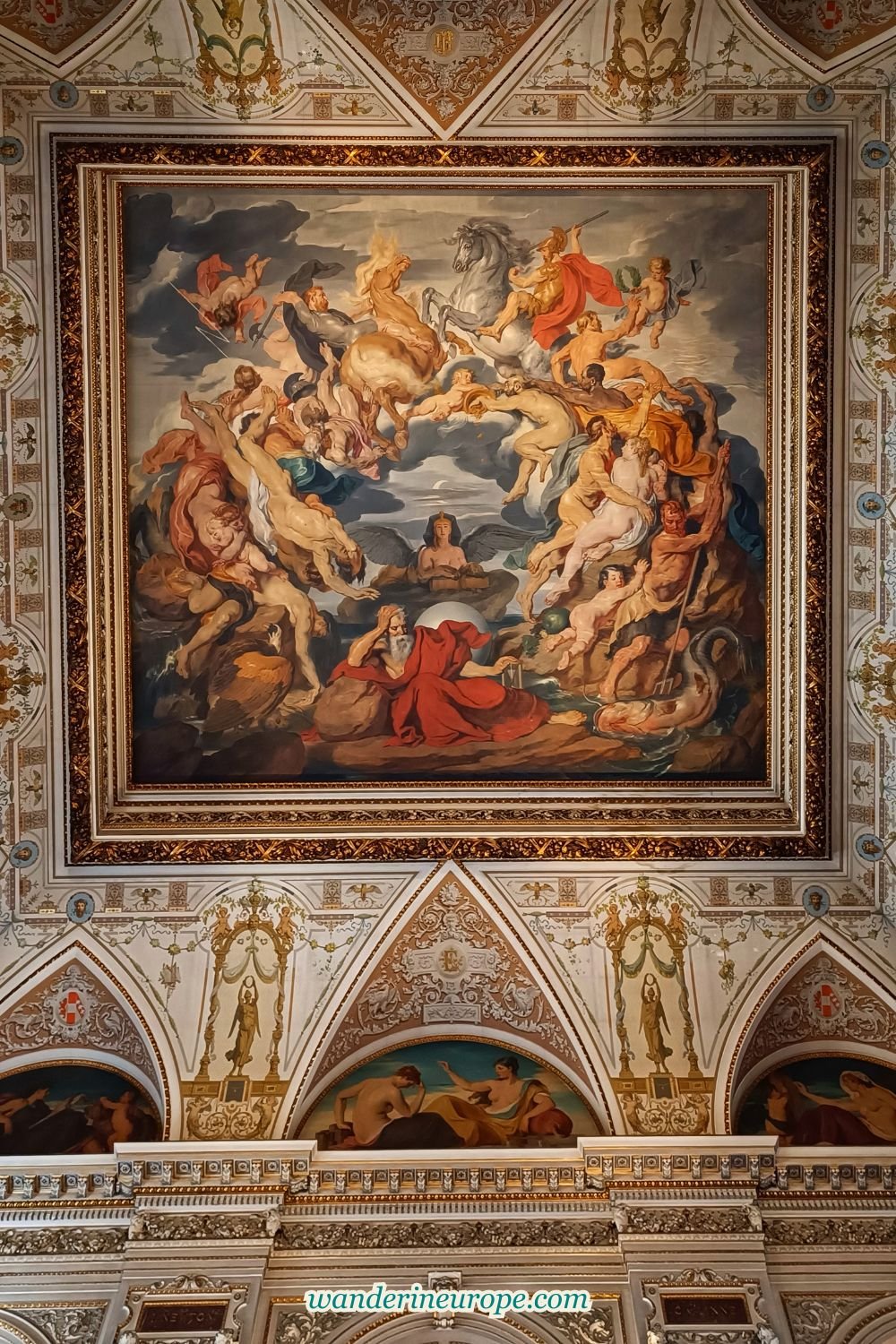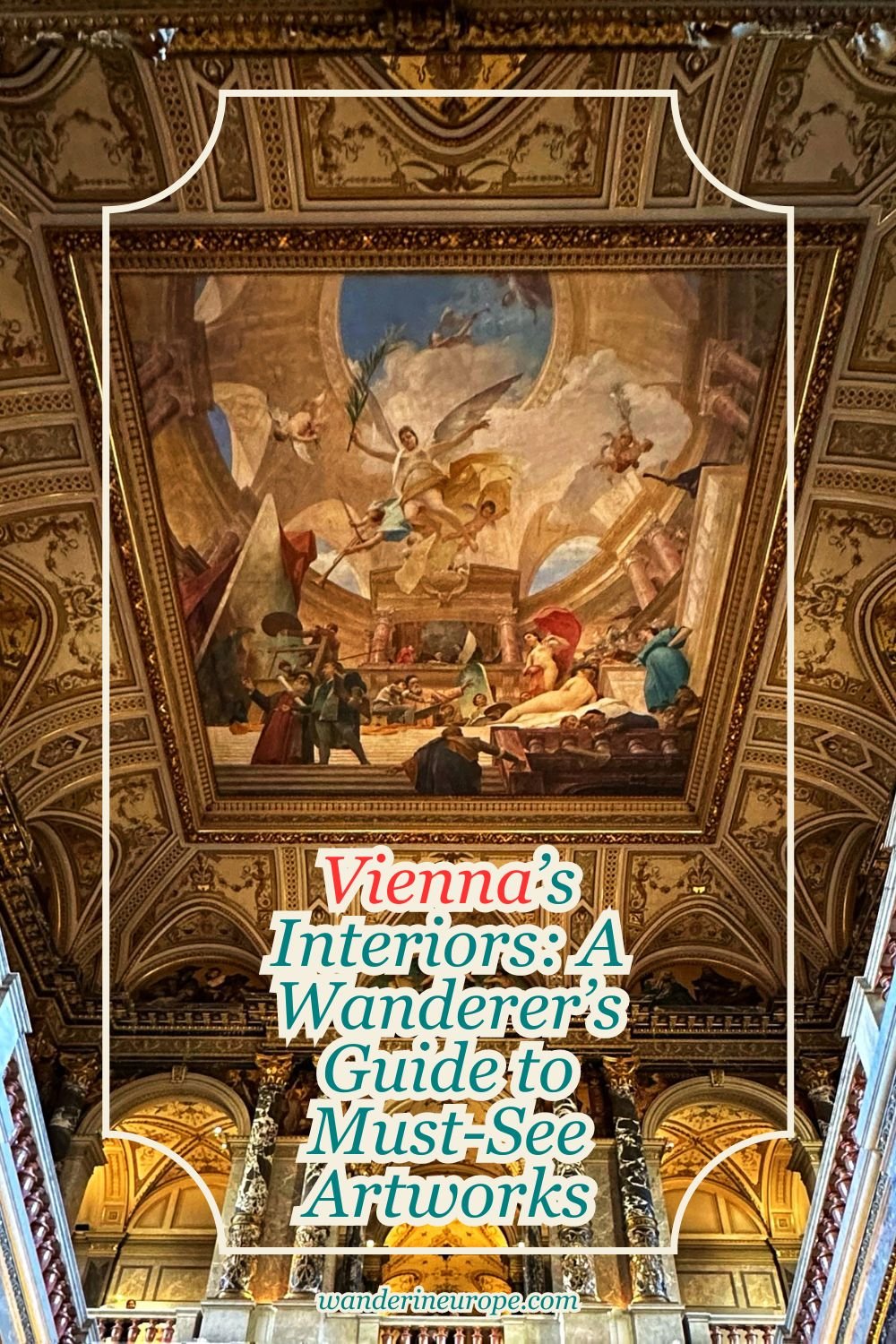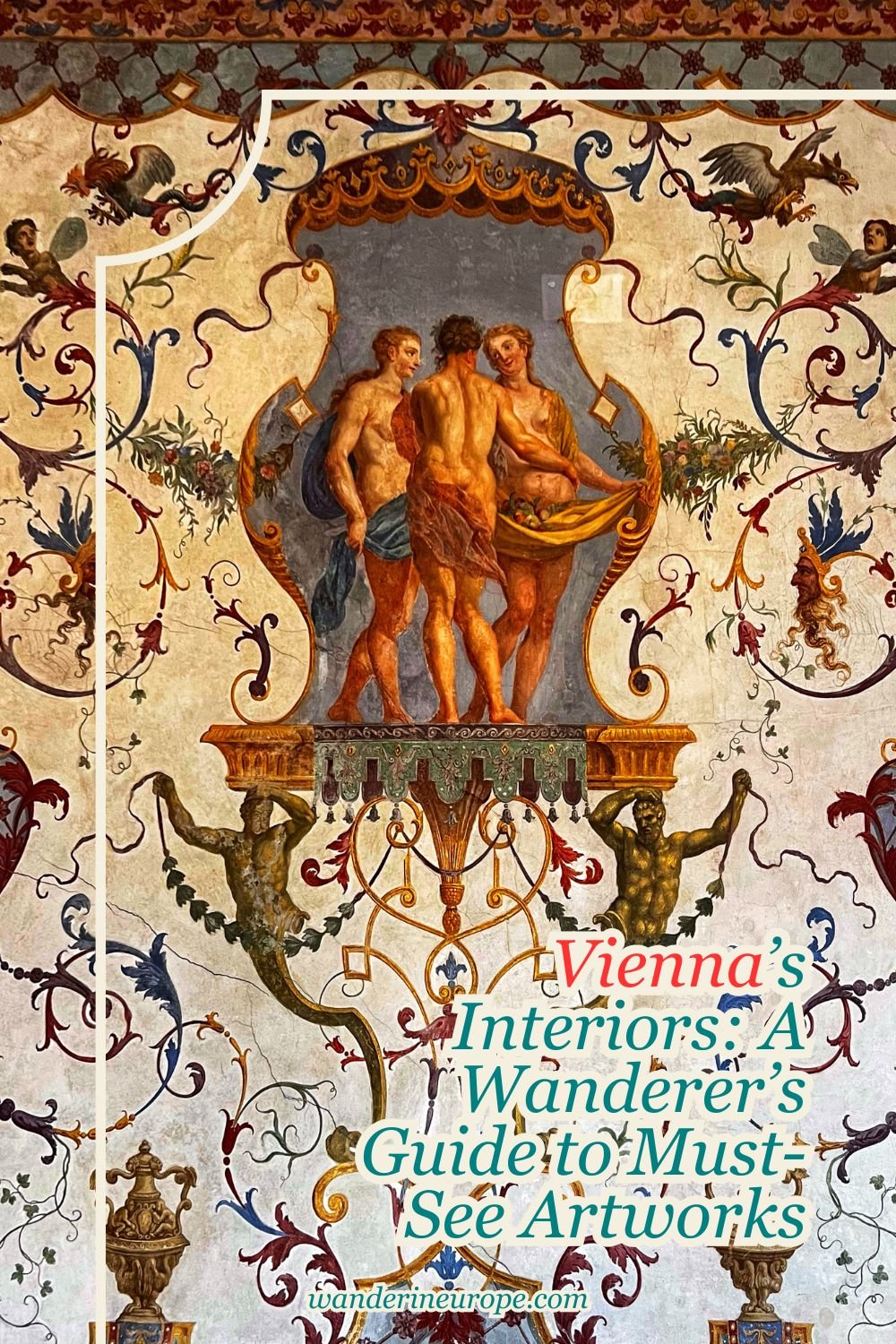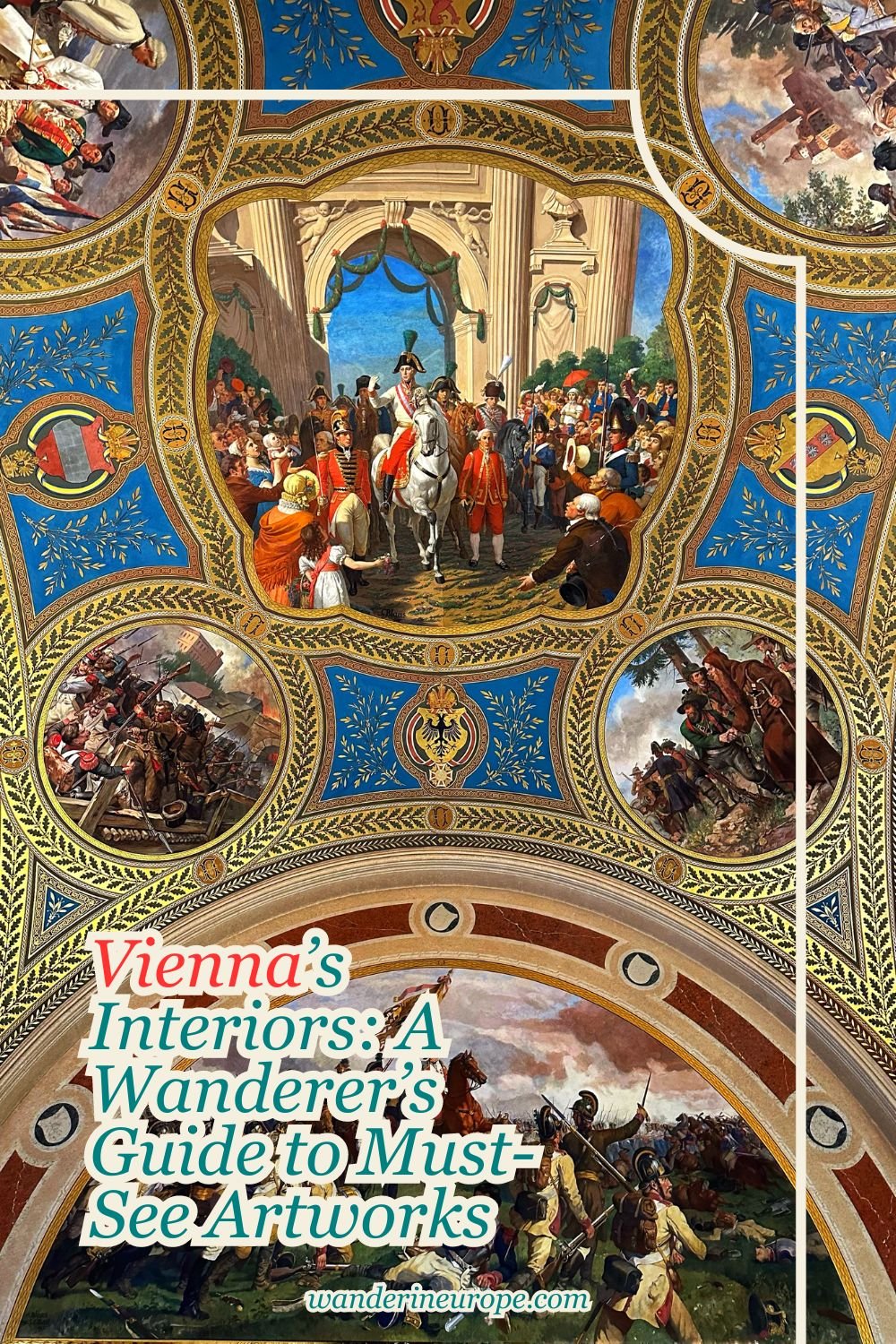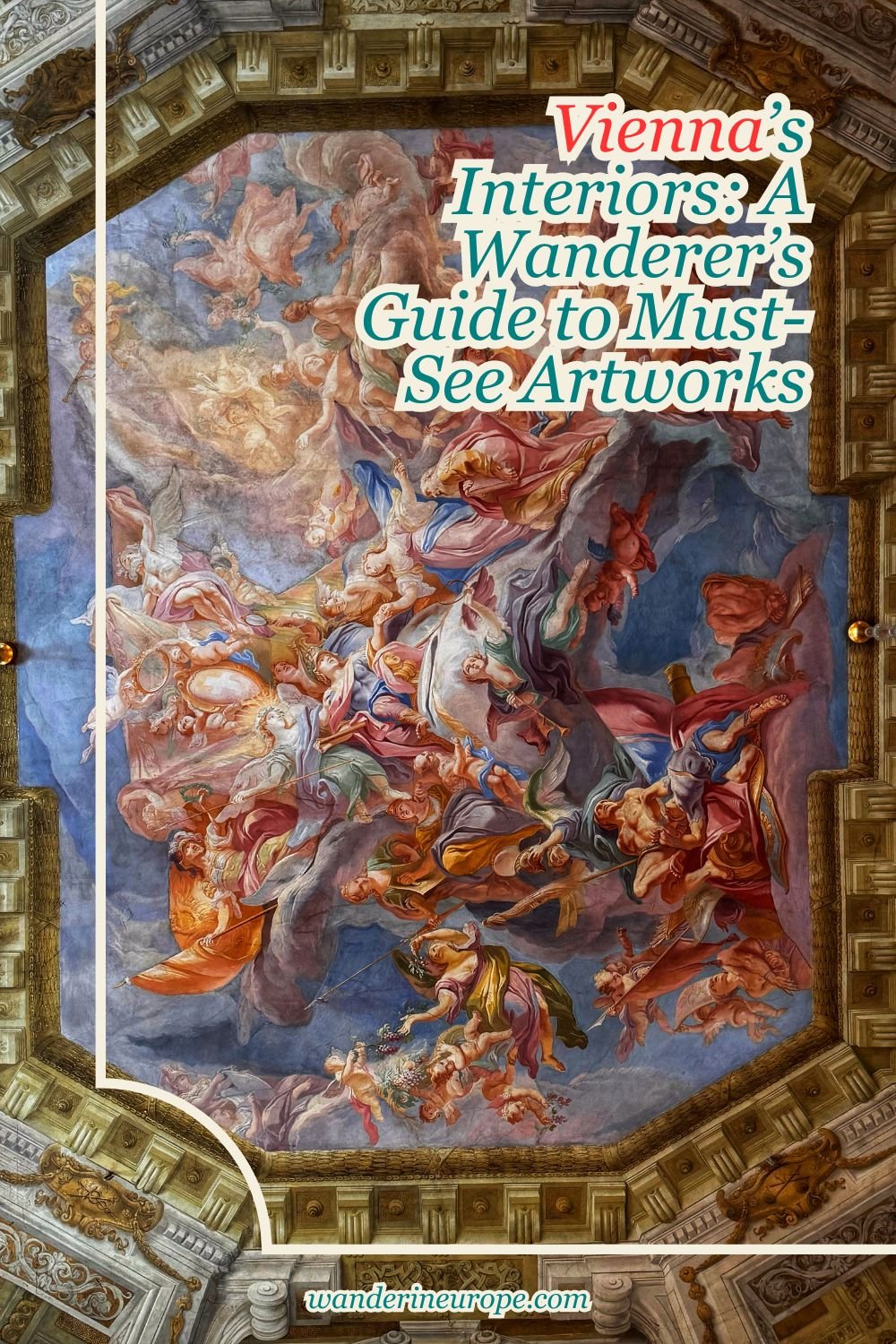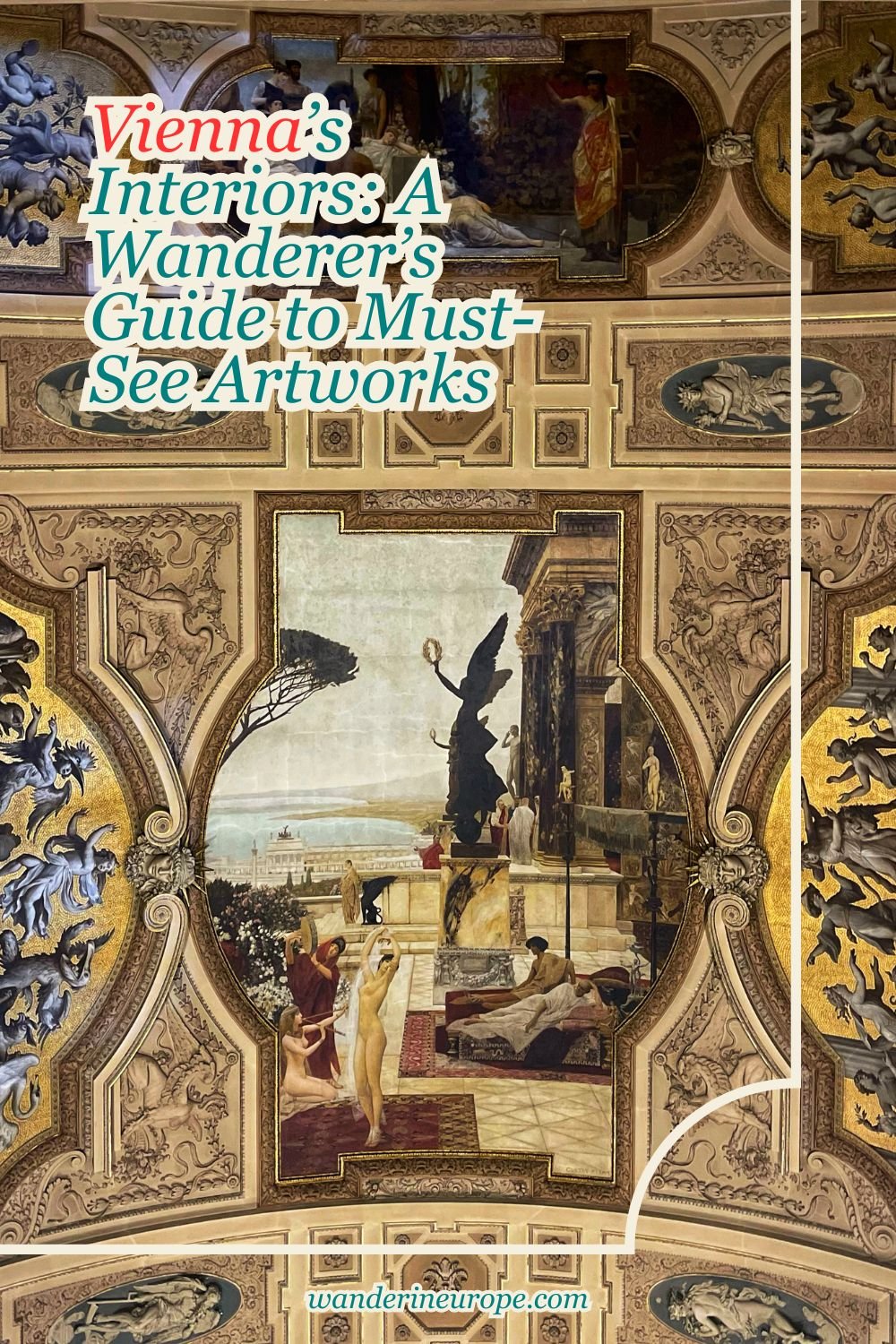Vienna’s Interiors: A Wanderer’s Guide to Must-See Artworks
WanderInEurope is reader-supported. Affiliate links and ads help us keep creating useful content for you.
1. The Patrons of the Fine Arts in the House of Habsburg in Hall XIX of KHM


Before anything else, allow me to introduce you to the people largely responsible for the beauty we can now all behold in Vienna: the Habsburg family.
They not only ruled Austria for centuries, but they were also safe keepers and patrons of art. Their reign was marked by a deep appreciation for the arts, leading to a rich collection of artworks and a legacy of patronage that significantly influenced European culture.
If there’s a place in Vienna that perfectly showcases the Habsburgs’ interest in art, undoubtedly, it’s the Kunsthistorisches Museum. Most of their collected pieces of artwork are beautifully exhibited in this museum.
Interestingly, the museum also houses a fresco that directly encapsulates the Habsburgs’ artistic legacy. It’s called “Patrons of the Fine Arts in the House of Habsburg” and it’s breathtaking.
You’ll need to crane your neck to take it all in because it’s absolutely huge! This magnificent fresco, painted by Julius Victor Berger, is located in Room XIX on the upper ground floor of the museum.
The fresco spans the entire ceiling of the room and showcases the rulers of the House of Habsburg who developed a deep passion for art and the collection of artistic objects.
The way Berger crafted this artwork is fascinating. The individuals depicted in the fresco are thoughtfully grouped: each emperor is painted alongside the artist they championed, creating a visual narrative of their relationships.

The ‘Patrons of the Fine Arts in the House of Habsburg’ is a must-see artwork for anyone visiting the Kunsthistorisches Museum. There’s more. Explore all the incredible finds awaiting you in the museum with my comprehensive guide to the Kunsthistorisches Museum.
Also, here’s something: Top Vienna Activities Under $100 (opens in a new tab)
2. Apotheosis of the Renaissance Above the Grand Staircase of KHM


When you visit the Kunsthistorisches Museum, you’ll find literally thousands of artworks to discover. They come in all forms, shapes, and sizes!
In fact, the museum building itself is a masterpiece. One look at this grand museum will instantly convince you it’s a work of art.
It becomes more apparent once you step into its spectacular staircase, which is just a few steps away from the lobby. Once you’re there, look up and the next beautiful fresco will catch your eye.
This is the Apotheosis of the Renaissance, painted by the Hungarian artist, Mihály Munkácsy. Created using the trompe l’oeil art technique, it adds an extra visual dimension.
It may appear three-dimensional, but in reality, it’s a flat painting! The fresco depicts a Renaissance building with a dome that’s open to the sky.
It brings to life the luminaries of the Renaissance art world. You’ll see Leonardo da Vinci, Raphael, Veronese, Titian, and Michelangelo — images that give visitors a hint of what they can discover inside.
3. Maler-Compagnie & Hans Makart Frescoes in KHM

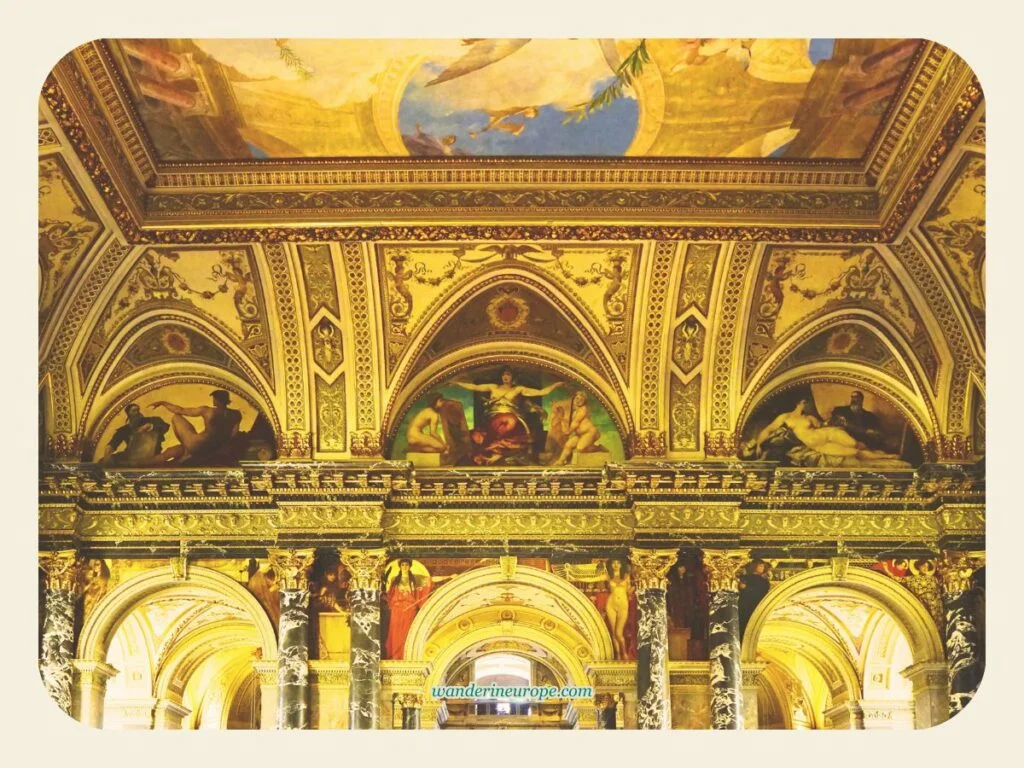

The Kunsthistorisches Museum offers a series of continuously beautiful impressions. As you look up from the staircase, more notable frescoes — spandrel and intercolumniation paintings — are sure to grab your attention.
They are impossible to miss, situated just below and around the Apotheosis of the Renaissance. If you are familiar with the works of Gustav Klimt, you’ll likely find these frescoes immediately recognizable.
This is because Gustav Klimt, one of the members of the group Maler-Compagnie, contributed to their creation. The other two members are his brother, Ernst, and Franz Matsch.
Above the spandrel and intercolumniation paintings by Maler-Compagnie, you’ll find nine equally stunning lunette pictures by Hans Makart. His artworks draw inspiration from various classical artists like Michelangelo, Titian, Raphael, Leonardo da Vinci, and more.
To me, the most striking of these artworks is undoubtedly the work of Gustav Klimt, which is situated above the grand staircase’s statue of ‘Theseus Defeats Centaur.’ These spandrel frescoes intricately portray the cultures that form the foundation of Western civilization.
As you move your gaze from left to right, you’ll notice influences from Roman, Venetian, Greek, Egyptian, and Italian cultures. Other spandrel frescoes represent a variety of cultures and artistic styles from different eras.
These can be seen as the ‘descendants’ of these ancient cultures. These include, but are not limited to, Baroque, Rococo, German Renaissance, Byzantine, Gothic, and more.
4. The Cycle of Life Above the Grand Staircase of NHM

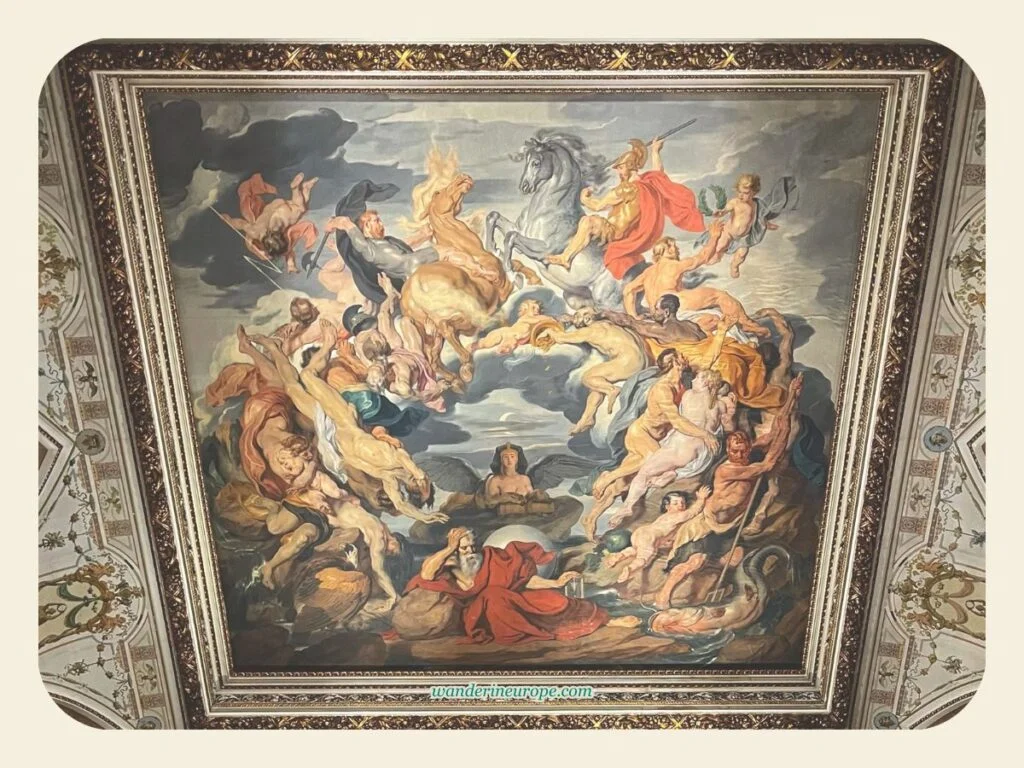

Did you know that the Kunsthistorisches Museum has a twin? It’s the Naturhistorisches Museum, which is just across Maria-Theresien-Platz where the twin museums are located.
Like its twin, the Naturhistorisches Museum also has a beautiful fresco above its grand staircase. Its Austrian painter, Hans Canon, calls it “The Cycle of Life.”
In the painting, you see lots of people moving in a circle, like a merry-go-round. This represents life as always moving and changing.
Among these people, there are two figures — a sphinx and a thinker, both deep in thought. They seem to be pondering over life’s big mysteries.
Here’s an interesting fact — Canon passed away in 1885, and his painting didn’t make it to the museum until 1888. But his ideas about life and culture live on in his masterpiece that now welcomes visitors to the Naturhistorisches Museum.
When you visit the museum, I suggest going to the area with the balustrade above the lower part of the grand staircase. There, you can find an information board indicating the meaning of the lunette frescoes surrounding ‘The Cycle of Life.’
5. Apotheosis of Charles VI on Hofburg’s State Hall Dome


If you’re currently at the Naturhistorisches or Kunsthistorisches Museum, the Hofburg, or the Imperial Palace, is just a street crossing away across Ringstrasse. It served as the winter residence of the Habsburg Monarchy and is the residence of the Austrian president today.
The Hofburg also acts as a cultural hub, housing multiple museums and traditional institutions, including the Lipizzaner Stallions.
Within the Hofburg also lies one of Austria’s most beautiful libraries, the Austrian National Library, specifically located in the Neue Burg. Here, you can observe people pausing to catch their breath, often due to the library’s fresco, ‘Apotheosis of Charles VI.’
Once your gaze falls upon this fresco that adorns the dome of the State Hall, I’m confident you’ll regard it as one of the city’s most impressive artworks.
The fresco portrays Emperor Charles VI as a wise ruler surrounded by various allegorical figures symbolizing virtues and knowledge. The emperor is depicted in the company of goddesses and other symbolic entities that represent the peace and prosperity he brought to his empire.
Interestingly, there’s a statue of Charles VI situated below the fresco. Its placement ingeniously creates a vertical line of sight, linking the earthly representation of the emperor with his celestial portrayal above.
And yes, if you’re planning a visit to the Austrian National Library, you should be thrilled, as there’s much more to discover.
The shelves themselves are masterpieces! Also, you’ll find other impressive statues, some embodying the four virtues: Prudence, Justice, Fortitude, and Temperance. Others are statues of emperors, scientists, and artists who have enriched Austrian culture.
As a wanderer, my favorite find was the Globus Novus, reputed to be the oldest terrestrial globe.

Planning a visit to the Hofburg? Make sure to take a look at my Hofburg guide. It’s packed with insights on the incredible experiences awaiting you there, plus tips to help you fully enjoy your tour.
6. The Ceiling Frescoes of Schonbrunn’s Great Gallery

Photography not allowed inside Schonbrunn Palace

As an explorer, you can expect to discover so much about the Habsburg Empire when you visit Vienna. Not only will you get to know different members of the Habsburg monarchy, but you’ll also gain an understanding of how these royals perceived themselves.
You’ll uncover their interests and curiosities, their intriguing international relations, and how some members of the monarchy aimed to conquer the continent not through war, but through blood and relations.
The thing is, learning in Vienna is a visual experience. You simply have to look at the artworks adorning the buildings or the sculptures placed in the parks to understand. Of course, everyone might need an audio guide sometimes!
If touring the state apartments and halls of Schönbrunn Palace is in your plans when you visit Vienna, you’ll have the opportunity to see such artworks — stunning frescoes — that provide insights into the Habsburg family.
Among the most impressive ones are located in the Great Gallery of the palace. There are three frescoes in it, but in summary, they depict the Habsburgs as virtuous and reformist rulers, as patrons of peace, prosperity, arts, and sciences, and as a formidable military power. They tell a story of the Habsburgs’ rule as a time of progress, prosperity, and power.
The central fresco of the Great Gallery speaks the glorious attributes of the Habsburgs the loudest. Here, you can see Maria Theresa and her husband Franz Stephan as the central figures, surrounded by the virtues of a ruler.
The inclusion of the Habsburg Crown Lands and their products signifies the economic and administrative reforms initiated by Maria Theresa, indicating a perception of themselves as progressive and reformist rulers.

The Great Gallery is just one small part of Schönbrunn Palace. There’s so much more to see! It’s a good idea to look at my guide to Schönbrunn Palace or my list of picturesque spots in Schönbrunn Palace before you go, so you don’t miss anything important.
7. The Frescoes All Over Bergl Rooms

Photography not allowed inside Schonbrunn Palace

When you’ve got the wealth and power of an emperor, you can pretty much do whatever you want. Traveling to distant places might be off the table due to your obligations, but who’s to say you can’t bring those distant places right to your doorstep?
That’s exactly what Maria Theresa did with a section of the Schonbrunn Palace, known as the Bergl Rooms.
Maria Theresa had this section of the palace transformed into a visually stunning tropical paradise, a place where she could escape during the sweltering summer days. As the years went by, she found herself increasingly affected by the summer heat.
So, these rooms essentially became her personal oasis during those hot times.
She brought in Johann Wenzel Bergl to outfit and adorn this section of the Schonbrunn Palace, which is how it got its name. Bergl turned the rooms into an awe-inspiring natural panorama, filled with exotic landscapes and peaceful garden scenes.
What really stands out about Bergl’s work is how he blurred the lines between the walls and the vaulted ceiling, with branches from exotic plants extending into the room.
All in all, Bergl transformed four rooms: The first room, an antechamber, showcases untouched natural scenery. The second room, likely a reception room, features painted silk draperies, peacocks, and fruit baskets, hinting at courtly culture.
The third room, the empress’s bedchamber, opens up to a formal Baroque garden, symbolizing princely power. The final room, probably a writing cabinet, gives the impression of being inside a shady pergola.
What’s really neat about the Bergl rooms is how one of them connects directly to the palace garden! The pergola depicted in the room’s painting mirrors what you’d see outside.
Bergl designed that room to give the impression of an augmented version of the garden beyond the walls.
8. The Frescoes Everywhere in the Crown Prince Apartment

Photography not allowed inside Schonbrunn Palace

Actually, there are two parts of Schönbrunn Palace that give visitors a sense of having traveled to a different side of the world. Aside from the Bergl Rooms, there’s the Crown Prince Apartment.
Adorned with beautiful frescoes or murals depicting nature, it bears a striking resemblance to the Bergl Rooms. Both are located on the ground floor of the palace and comprise four rooms each, inviting visitors to wander around.
The walls of these rooms served as a canvas for Bergl, who depicted idyllic landscapes. However, Ludwig Geyling later breathed new life into these landscapes.
He made the rooms feel more spacious and open by adding trees and shrubs, which enhanced the blurring of the lines between the walls and ceiling.
If you were to ask me which one looks better, I’d choose the Crown Prince Apartment. As someone with a romantic spirit, I find the scenery depicted in this room more appealing.
The walls of the Crown Prince Apartment are like windows to a world where cities and palaces peek from the horizon, and statues and fountains dot the scenery. They really inspire my adventurous self.
9. The Ceiling and Walls of the Hall of Grotesques


When it comes to sheer beauty, the palaces are an obvious choice. They served as the residences of the empire’s most influential figures. It’s easy to see why the places they called home are so extraordinary.
In Vienna, however, there’s another notable palace you can visit aside from Schonbrunn Palace and the Imperial Palace.
This is Belvedere Palace, located just on the outskirts of the Old Town. It was the residence of Prince Eugene of Savoy, an art enthusiast and a military commander who greatly helped Vienna during the Turkish Invasion of the city.
Just like the first two palaces I mentioned, Belvedere Palace is another Baroque masterpiece, filled with artistic architectural elements. One area that I found really interesting was the Hall of Grotesques, located within Lower Belvedere, one of the two main structures of Belvedere Palace.
The frescoes adorning the walls and ceiling of this hall held my gaze in wonder for quite some time.
In a sense, they brought to mind the medieval books I came across in the Austrian National Library, as well as the wall panels I discovered at Oberhofen Castle in Lake Thun, Switzerland.
One fresco that caught my eye depicts Vulcan’s Forge, a tribute to the Roman god of fire and metalworking. This scene underscores the artistry involved in forging something new and seems to embody the essence of creation and masculine energy.
The hall’s walls also showcase a fresco of the Three Graces, three goddesses from Greek mythology who symbolize charm, beauty, and creativity.
If you glance upward, you’ll find the Four Seasons and the Four Elements adorning the ceiling, symbols of the ceaseless cycle of time and the fundamental elements of life as understood in ancient times. These breathtaking frescoes are the work of Jonas Drentwett, a talented artist hailing from Augsburg.
10. The Ceiling of the Marble Hall

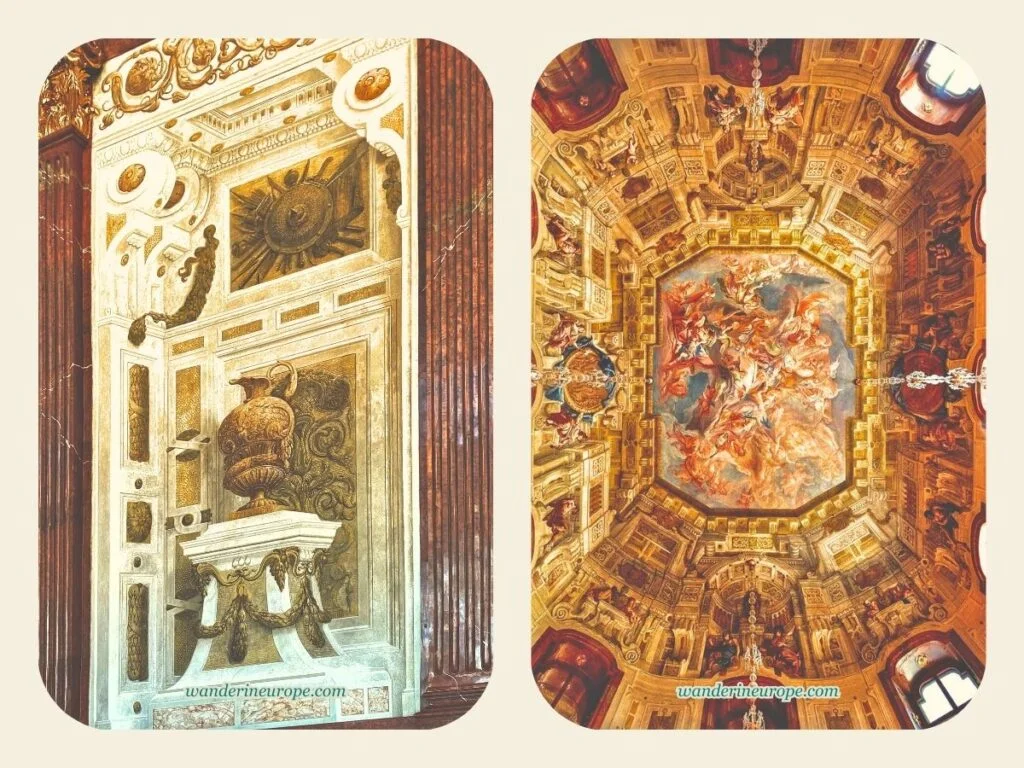

You have the option to tour the Lower and Upper Belvedere Palaces individually. But if you’re a fan of both architecture and art, I’d suggest you don’t miss the Upper Belvedere.
It’s not just the home of Gustav Klimt’s renowned painting, The Kiss, but it also showcases stunning frescoes that are just as mesmerizing as Klimt’s work.
In fact, one of these frescoes leaves visitors in awe as soon as they step into the Upper Belvedere. Situated on the high ceiling of the Marble Hall, the fresco subtly encourages visitors to tilt their heads back and absorb every detail once they got it.
Just like the first frescoes I’ve shared with you, the one in the Marble Hall of the Upper Belvedere is a trompe l’oeil. This technique creates an illusion that the Marble Hall is taller than it actually is.
I’m really impressed by how the artists, Carlo Innocenzo Carlone, Marcantonio Chiarini, and Gaetano Fanti, managed to visually integrate the fresco seamlessly with the Baroque elements on the walls of the Marble Hall. Their artistry also had me convinced at first glance that the hall was at least three stories high.
For the best view and to fully appreciate the illusion, I recommend standing in the center of the hall.
Also, don’t miss the frescoes on the walls of the Marble Hall.
The rich gildings and the four chandeliers might catch your attention first, but these pieces of wall art are a must-see, too! It’s amazing how these artworks add an extra visual dimension to the room.
Good to know: The Lower Belvedere also boasts a magnificent Marble Hall, equally stunning to the one found in the Upper Belvedere Palace. You’ll also discover beautiful frescoes there.
11. The Triumphs of Aurora in the Carlone Hall

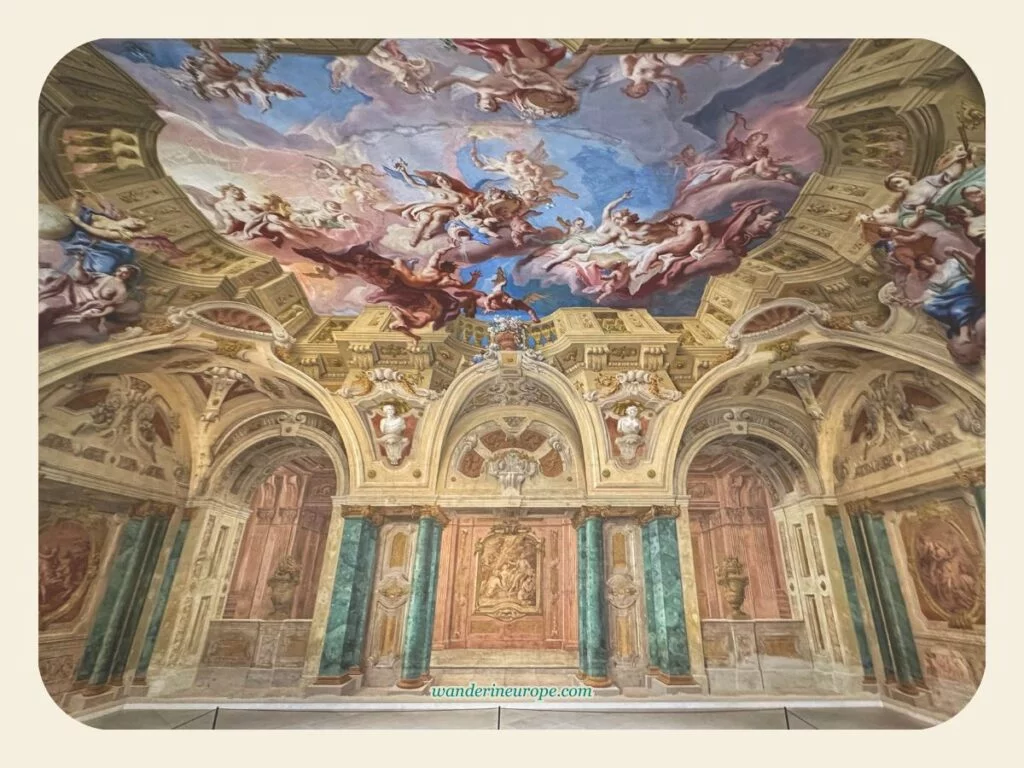

Once you’re in the Marble Hall of the Upper Belvedere, you’re literally just a few steps away from another impressive fresco in the palace. It’s called the Triumphs of Aurora and is located in the Carlone Hall, accessible from the Marble Hall.
The fresco, painted by Innocenzo Carlone, a North Italian fresco master and itinerant artist, is sure to make you marvel.
Not an inch is left blank. No matter where your eyes wander, you’ll be taking in colorful artistic scenes. The frescoes in the room were made using the trompe l’oeil technique, making the room appear larger than it actually is.
As the title of the artwork suggests, it depicts Aurora, the goddess of dawn, leading the way for Apollo, the god of light. Accompanying Apollo’s chariot are elegant female figures known as Hours, representing the passage of time. Their diaphanous draperies, gently blown by the wind, add a sense of movement to the scene.
The figures are represented in an ideal manner, flawless and perfect in their beauty, embodying the timeless and ageless nature of these mythological beings.
This magnificent fresco, with its soft pastel color palette, lends an idyllic, mythic quality to the scene, making the Carlone Hall a really remarkable part of the Belvedere Palace.

The Carlone Hall, the Hall of Grotesques, and the Marble Hall are just a few of the stunning sights you’ll encounter when you visit the Belvedere Palace. If you’re considering adding this palace to your itinerary, my guide to the Belvedere Palace can help you maximize your experience.
12. Ruhmeshalle Frescoes in the Museum of Military History


Sometimes in Vienna, it’s a challenge to figure out if you’re in a museum or a palace. I’m sure that’s a feeling you’ve already picked up from our discussions.
Consider the Belvedere Palace, which is actually an art museum. Then there are the Kunsthistorisches Museum and Naturhistorisches Museum, filled with historical artworks and natural artifacts, yet they have the grandeur of palaces.
Another place that falls in the category is the Museum of Military History. It’s more like a fortress than a museum, but the splendor you’ll find there could rival the KHM and NHM.
The beauty I’m talking about is almost everywhere throughout the Museum of Military History, but it really shines in the Ruhmeshalle, or the Hall of Fame, which is adorned with vibrant frescoes.
The thing is, the works of art you’ll find in the Ruhmeshalle are not merely for decoration. They tell the story of Austria’s military strength, highlighting key events from the time of the Babenberg dynasty.
Each stroke of the brush pays homage to the nation’s military triumphs and rich history — from the loss of some soldiers to the triumphant return of the heroes — these pieces of art reveal the greatness of the Austrian Empire.
Honestly, they’re among my favorite frescoes. Looking at them gives me the feeling that I’m watching the movies that inspired me to explore in the first place.

If, like me, you’re intrigued by the various forces and events that have shaped Europe over the centuries, I’d recommend exploring Museum of Military History deeper. The exhibits are fascinating — from the Turkish tent to the Sarajevo car that marks the onset of World War I. Here’s my guide to help you get the most out of your visit to the Museum of Military History.
13. Burgtheater Ceiling Frescoes


It turns out that in Vienna, it’s not just the museums and palaces that leave a lasting impression on visitors from the moment they arrive.
The city’s theaters and opera houses are also noteworthy. They are spectacular not only for the performances they host but also for their architecture.
For instance, if you get the chance, take a quick sneak peek inside the Burgtheater. This Neo-Renaissance landmark is the most prestigious German-language theater, also renowned for housing Klimt’s most impressive frescoes.
Together with his brother, Ernst Klimt, and his colleague, Franz Matsch, they adorned the ceiling of the Burgtheater’s staircases with mesmerizing imagery.
The cycle of paintings in the left-hand staircase features the ‘Altar of Apollo,’ the ‘Ancient Ex-Tempore Actor’ by Franz Matsch, ‘The Theatre at Taormina’ by Gustav Klimt, the ‘Medieval Mystery Play’ also by Matsch, and Ernst Klimt’s ‘Clown on a Fairground Stage.’
In the right staircase, however, the frescoes depict the evolution of theater and features three classical playwrights. The left-hand side highlights themes of music, dance, medieval mystery plays, and the ex-tempore stage.
My favorite piece is the fresco above the stairwell on the ‘Volksgarten’ side, which portrays the London Globe Theatre and the final scene from Shakespeare’s ‘Romeo and Juliet.’
I was really impressed when I learned that Klimt was only 24 when he created these masterpieces in the theater.
14. Fama Angel Announcing Glory in the Theater Museum


I have to tell you—there are so many interesting discoveries that await you in Vienna. They’re quite surprising, actually! The best part is, they’re just within the Old Town.
Among the amazing attractions I found is the Theater Museum, which is definitely a gem!
The museum puts on a range of exhibits that focus on theater, dance, and performance art. You’ll see historical costumes, set designs, and props. This could offer a fresh perspective on your Vienna trip, beyond the typical cultural experiences tied to the Habsburgs.
A standout feature of this museum visit could be the interactive exhibitions that allow you to engage directly with theatrical artifacts. For enthusiasts, the opportunity to watch rare footage of historic performances and legendary productions in the museum could be a remarkable find.
But for explorers like me, the real treasure is the breathtaking trompe l’oeil fresco on the ceiling of the Eroica Hall in the museum. It’s known as the Fama Angel Announcing Glory.
This fresco in the Theater Museum, much like the ones in the Burgtheater, portrays characters associated with theater, music, and performance.
Yet, unlike the heritage-rich frescoes in the Burgtheater, this one in the Theater Museum celebrates various forms of creativity, showcasing allegories of architecture, design, music, poetry, and more.
Here’s a fun fact: the Theater Museum is situated in the Palais Lobkowitz, which is just a short walk from Hofburg. The prince who once owned the palace was a close associate of Ludwig van Beethoven. That’s why the Eroica Hall was named after Beethoven’s third symphony, the Eroica Symphony. And guess what? This symphony was actually dedicated to the prince!
15. Palais Daun-Kinsky Staircase Frescoes

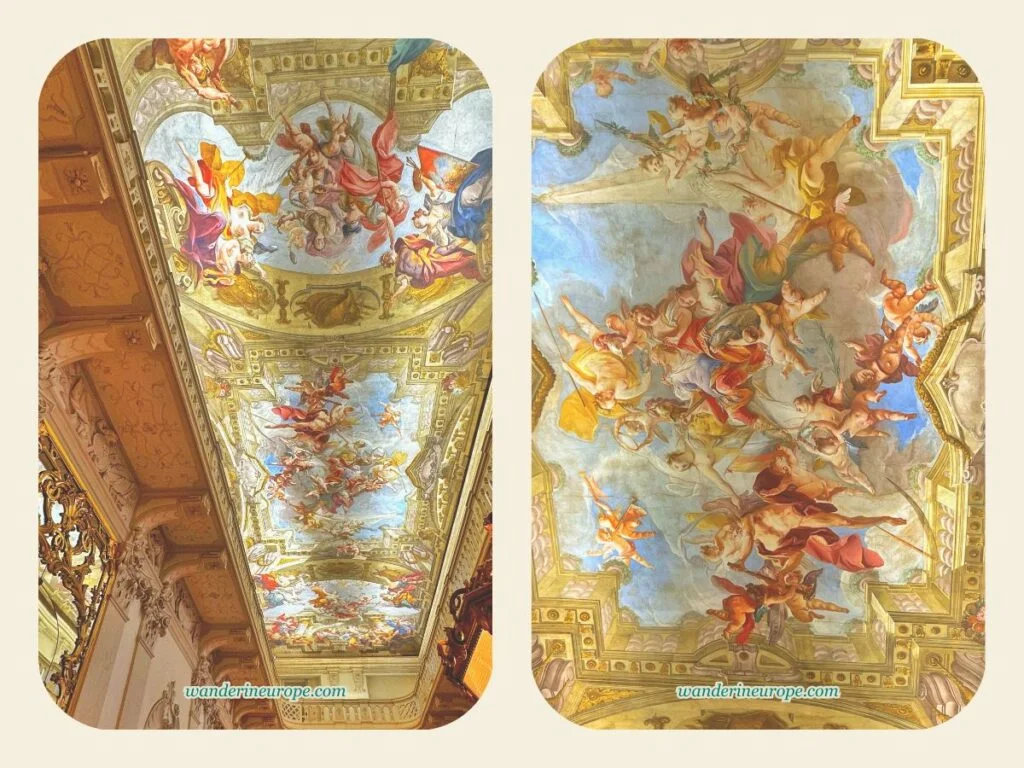

As we’ve just explored in our discussion about the Theater Museum, Vienna is home to more than just its most famous palaces: the Imperial Palace, Schonbrunn Palace, and Belvedere Palace.
Another gem I can’t wait to tell you about is the Palais-Daun Kinsky.
What’s exciting here is that you can walk right in and gaze upon its spectacular staircase, adorned with breathtaking frescoes, all for free!
This Baroque palace is among the most stunning in the Old City. The ornate staircase, embellished with intricate stuccoes and colorful frescoes, is just a taste of the visual feast that lies within.
By looking at the frescoes, you can get an idea of the person who owned the palace. The frescoes depict Count Wirich Philipp von Daun experiencing an apotheosis. There, he is surrounded by fanciful characters like cherubs, occasional strongmen, and bare-breasted beauties.
Interestingly, the frescoes were also the works of Innocenzo Carlone and Marcantonio Chiarini — that alone can assure you that what you’ll behold will be pleasing to the eye.
If you’ll be visiting Freyung and Schottenkirche on a walking tour of the old town, you won’t regret adding Palais Daun Kinsky to your itinerary.
Lastly, different events take place inside the palace like concerts. It’s an opportunity for you to see the rest of the palace and have some special musical experience in the city.
16. Heroic Deeds of Hercules in the Liechtenstein Garden Palace

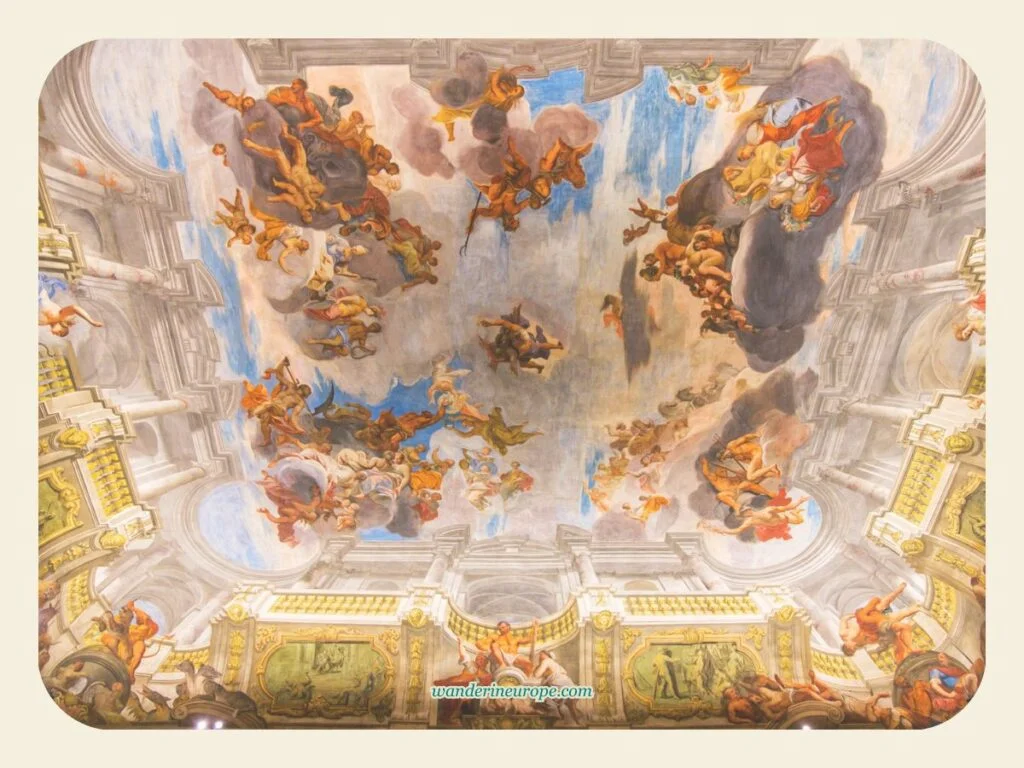

Of course, you can find more palaces in Vienna outside the old town.
They might not be as famous as the three main palaces in the city, but they are still absolutely worth considering for three reasons: architectural beauty, an abundance of artworks, and beautiful gardens.
A prime example is the Liechtenstein Garden Palace, located outside the Ringstrasse. (Don’t confuse it with the Liechtenstein City Palace, which you can find within the old town).
It houses private art collections, including one of the largest Rubens collections and key works by artists such as Van Dyck, Cranach, Raffael, Rembrandt, and Hamilton.
As for its architecture? It was designed by well-known architects and artists of its time, including Johann Bernhard Fischer of Erlach, Marcantonio Franceschini, Antonio Bellucci, and Andrea Pozzo.
When I learned about their involvement in the design of the Liechtenstein Garden Palace, I knew I wouldn’t be surprised to find another impressive fresco there: the Apotheosis of Hercules.
This fresco is specifically located in a very spacious hall named after the demigod: Hercules Hall. In the fresco, you can see Hercules being crowned with a laurel wreath while being surrounded by different gods and mythical characters.
Similar to other frescoes in magnificent places in Vienna, this artwork in the Liechtenstein Garden Palace was also applied with the trompe l’oeil technique, giving the hall an extra visual vertical dimension. It makes the spacious hall appear even larger!
By the way, the artwork is enormous, covering the entire area of the hall. To give you some perspective, the Hercules Hall has an area of 530 square meters, making it Vienna’s largest secular baroque hall.
18. The Dome Frescoes of Peterskirche


Even the churches in Vienna resemble palaces, thanks to their ornate Baroque interiors.
Indeed, these are places one should not overlook when seeking impressive frescoes. Among the Baroque churches I discovered, Peterskirche stood out. Its beauty led me to believe that it’s the most exquisite Baroque church in Vienna.
The frescoes adorning the narthex, dome, and pendentives contribute significantly to this impression. Of the three, the dome is the most notable. The elaborate fresco in the dome beautifully captures the glory of the Holy Spirit, depicted as a dove guiding the people surrounding it.
I admire how the creators of the church positioned the fresco of the Holy Spirit in the lantern of the dome. The light entering through the small windows of the lantern creates an ethereal effect.
If you don’t have a camera that can zoom multiple times or binoculars, it’s tough to see the small details in the Peterskirche dome paintings. But there’s no need to worry! There’s a big picture of it near the entrance. You can see all the details in that picture easily!
Just below the dome, you can find the pendentives, adorned with images of saints that appear lifelike due to the 3D art technique used on them. The saints’ garments, overlapping layers of the pendentives, will make you do a double-take to determine if they’re real cloth or merely paintings!

If you wish to examine these features more closely, check out my guide to Peterskirche. I’ve documented all the beautiful parts of the church and the various experiences you can have when you visit.
18. The Dome Frescoes of Karlskriche


Frankly, choosing the most stunning Baroque church in Vienna between Peterskirche and Karlskirche is a tough call.
Karlskirche stands out with its unique facade, a blend of various architectural styles. If you’re an architecture enthusiast like me, you’ll be mesmerized by the twin columns at the front, reminiscent of Rome’s Trajan’s Column.
But the facade is just the tip of the iceberg. As you step inside, prepare to be awestruck. Your eyes will be drawn to the gilded high altar, adorned with the Tetragrammaton and statues of St. Charles Borromeo in his Apotheosis.
And let’s not forget about Karlskirche’s stunning frescoes, which I believe are among the most beautiful in all of Vienna
While there are many frescoes in Karlskriche, the one embellishing the dome stands out. Its design mirrors that of Peterskirche, featuring windows and a lantern adorned with a dove or Holy Spirit painting.
The fresco depicts scenes from St. Borromeo’s life, easily identifiable by his cardinal’s hat and cross, surrounded by the virtues of faith, hope, and love.
Other than the frescoes, don’t miss the gallery near the choir, flanked by two angels. The curtain they hold, unbelievably, is made of stone. The craftsmanship is simply astounding.

There’s much more to see in this church. If you’re curious, check out my detailed guide to Karlskirche. It covers the beautiful elements of the church’s interior and exterior, as well as the unique experiences it offers.
19. Jesuit Church’s Quadratura


Among the frescoes in Vienna with illusionistic characteristics, I believe the ones in the Jesuit Church have the most powerful illusion.
Unlike the typical trompe-l’oeil techniques, these frescoes employ ‘Quadratura’. This method is rooted in 17th-century theories of perspective and architectural space representation.
The church’s ‘dome’, located in the middle of the nave, is a prime example of this illusionistic style. Despite being painted on a flat ceiling surface, it gives the impression of a three-dimensional dome, particularly when viewed from a distance, such as from the church’s narthex.
As you walk along the nave towards the altar, the appearance of the dome painting changes, revealing its true 2D nature.
This awe-inspiring artwork is the creation of Andrea Pozzo, renowned for his grand frescoes using the quadratura technique. His works can be found across Europe, including the Church of Saint Ignatius in Rome.
For those interested in exploring more of such impressive artworks in Austria, consider spending a day in Innsbruck.
This town, nestled in the breathtaking Austrian Alps, is home to the Innsbruck Cathedral. Designed by the famous Asam Brothers of Bavaria, the cathedral also features Quadratura frescoes. If memory serves me right, it has three domes adorned with this unique form of artwork.
20. Byzantine-Style Frescoes in the Holy Trinity Greek Orthodox Church

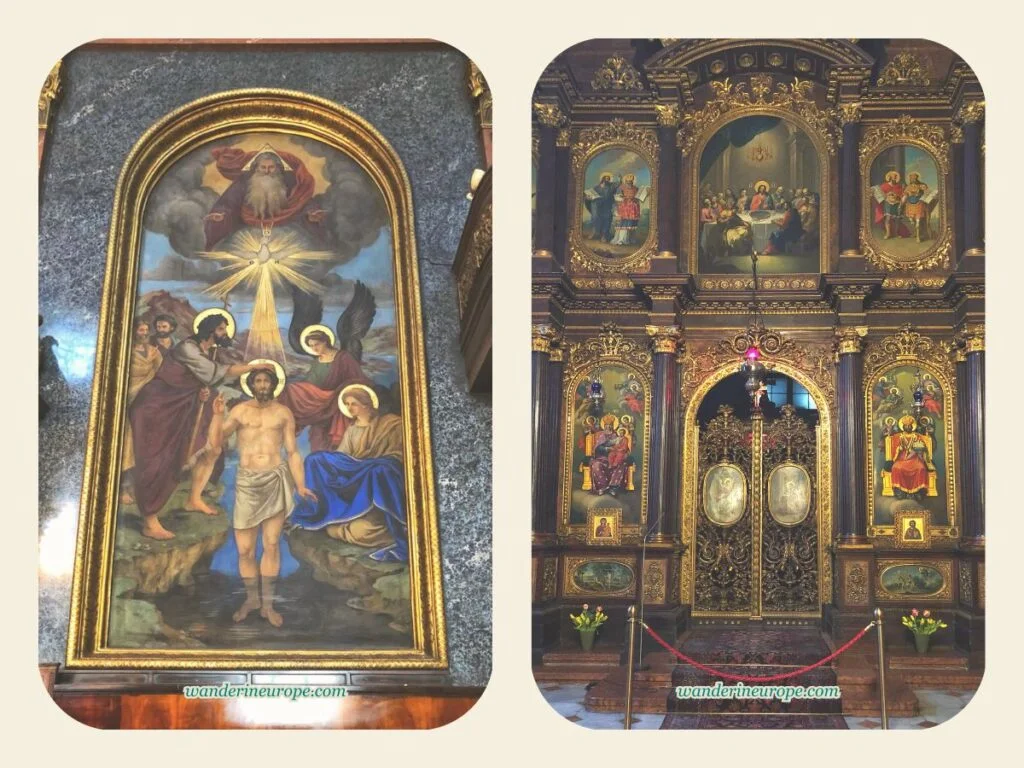

Last but not least — Vienna, though not in southeastern Europe, is a city where one can admire the Byzantine style of art and architecture.
A prime example of this style is the Holy Trinity Greek Orthodox Church, located in the historic Greek neighborhood of the Old Town, also known as Fleischmarkt. This church is home to stunning frescoes that stand out for their unique appearance. What sets these frescoes apart?
The first thing you’ll notice is the extensive use of gold and the flat, frontal figures.
Unlike other frescoes that often feature ordinary humans and allegories with a touch of Renaissance, the frescoes here primarily depict Jesus, Mary, and other saints. The golden glow of the saints’ halos is particularly eye-catching.
One fresco or artwork that caught my eye is the baptism of Christ, which includes an image of the Holy Trinity.
But it’s not just the frescoes that make this church special. The architecture itself is a blend of Byzantine style with elements typical of Germany and Austria, making it a unique sight.
Indeed, for anyone with an interest in architecture, the Holy Trinity Greek Orthodox Church is a must-visit destination in Vienna.
From great hotel deals to skip-the-line tickets and affordable eSim to cheap rentals, click here for the best hotel deals and more travel discounts.
Visit Vienna
For ideas and inspiration on making the most of your visit to Vienna, check out the travel plans below.
Find all the travel guides to Vienna and its tourist attractions below.
Resources
So, those are some of the most amazing frescoes in Vienna! They’re really beautiful, right? If you think I forgot something, just let me know in the comments. I’d love to hear from you. If you want to know more about these wall paintings, you can find more info, videos, and pictures in the links below.
- Names of the people depicted in the Patrons of the Fine Arts in the House of Habsburg
- Details for the lunettes in Kunsthistorisches Museum
- About the State Hall where the Apotheosis of Charles VI is located
- Insights into the frescoes adorning the Great Gallery of Schonbrunn Palace
- More information about the Bergl Rooms of Schönbrunn Palace
- Fun facts about the Crown Prince Apartment in Schönbrunn Palace
- Overview of the architecture of the Lower Belvedere Palace
- Learn more about the architecture of the Upper Belvedere Palace
- Virtual Tour of the Hall of Fame of the Museum of Military History
- Introduction video for Liechtenstein Garden Palace
For the locations I haven’t covered in a dedicated blog post, you can visit their official websites linked below. These sites will have the most up-to-date information for visitors, which could be useful if you’re planning a trip to Vienna.
- Naturhistorisches Museum
- Palais Daun-Kinsky
- Jesuit Church Vienna
- Holy Trinity Greek Orthodox Church
- Liechtenstein Garden Palace
For a convenient, unique, or more enriching visit, check out these experiences and services:


Pin this to save it for later or bookmark it to read anytime.


